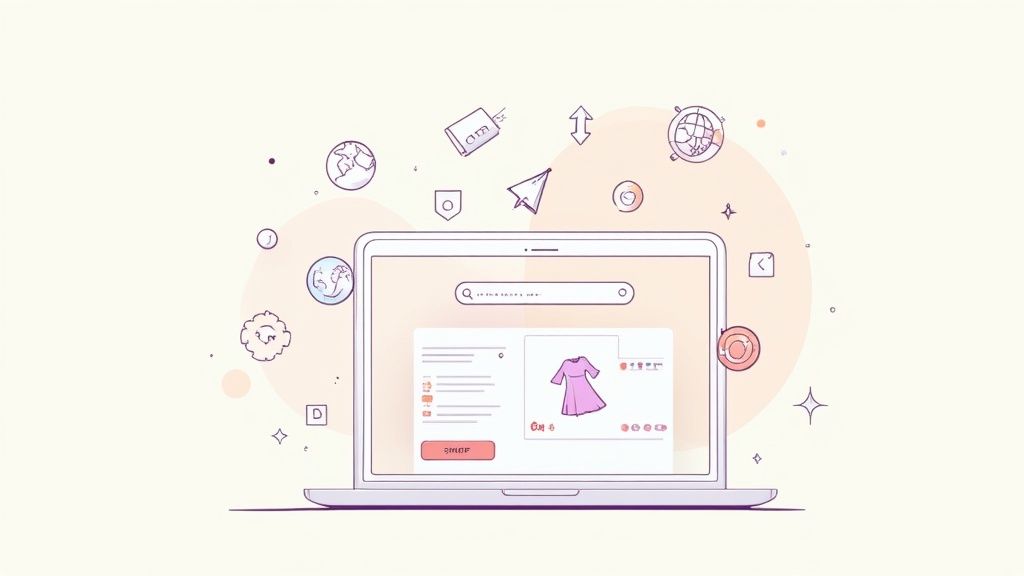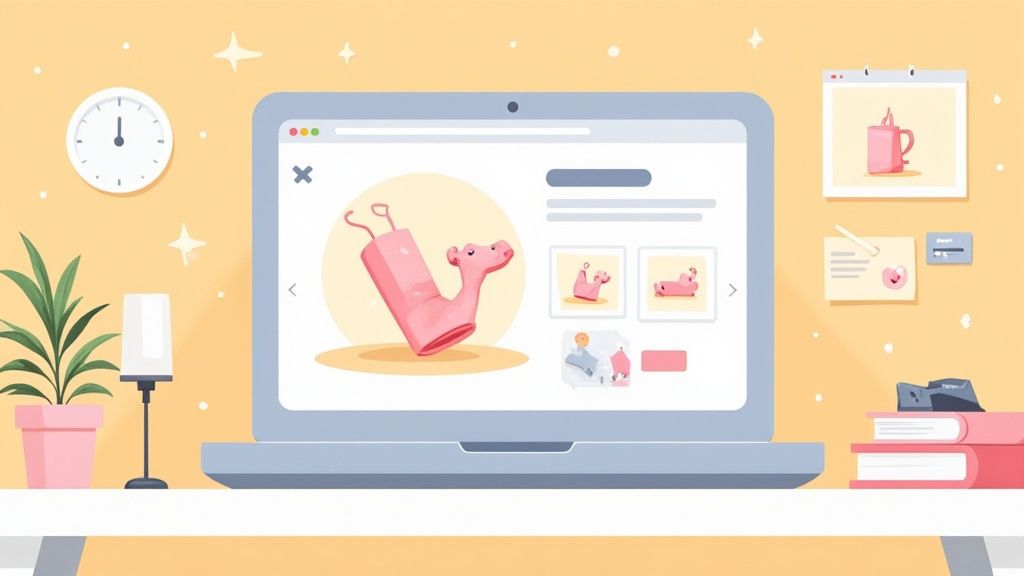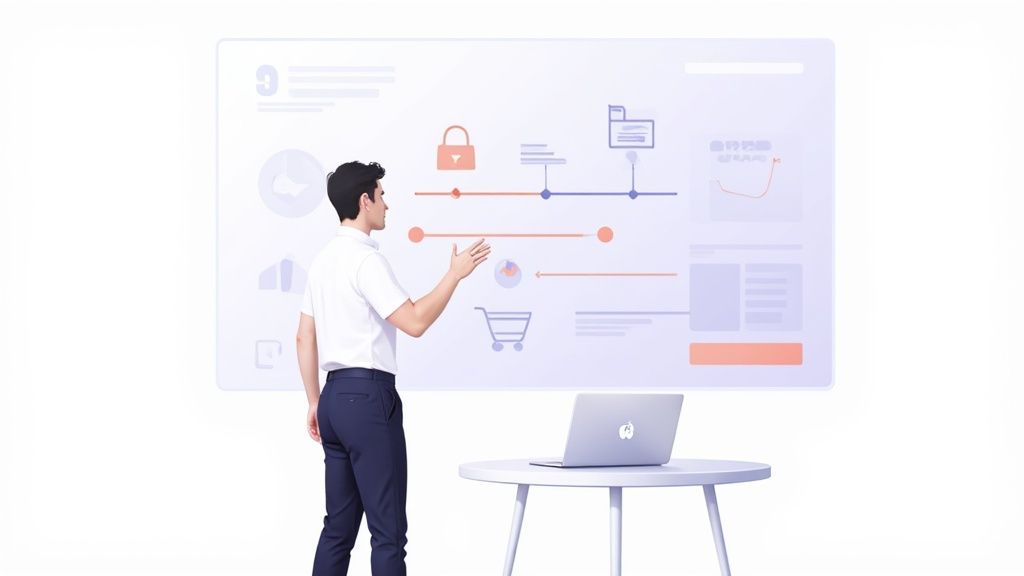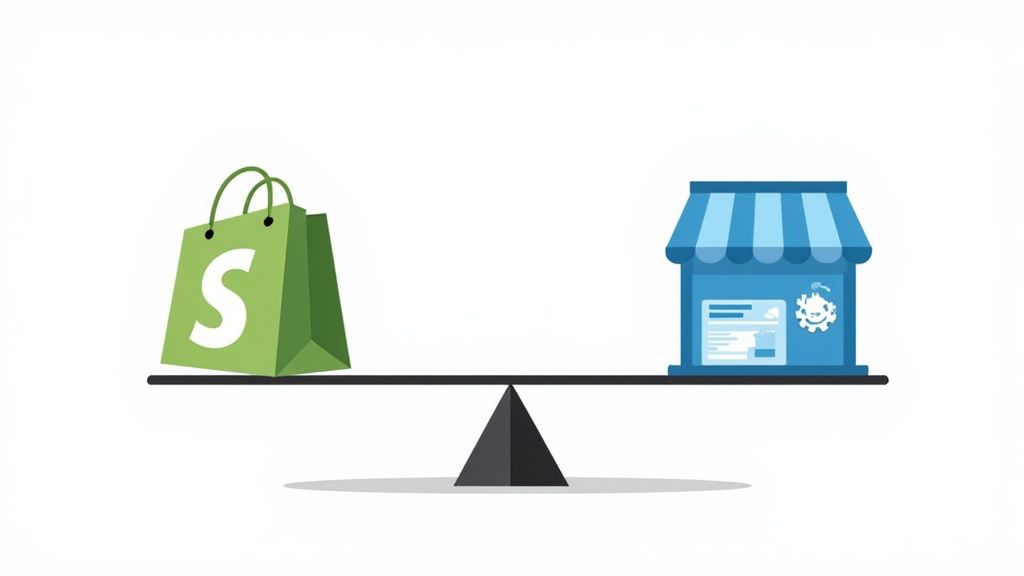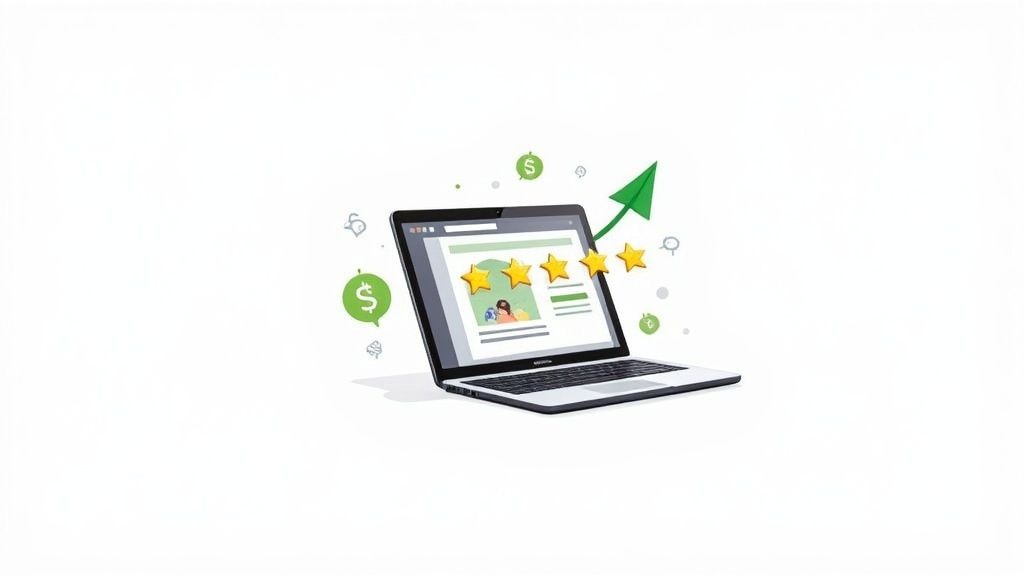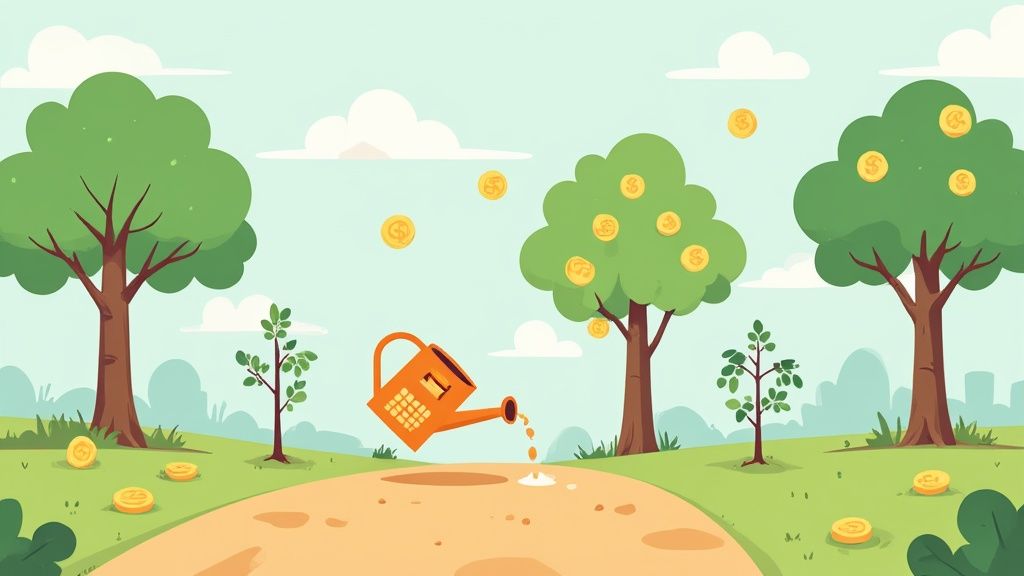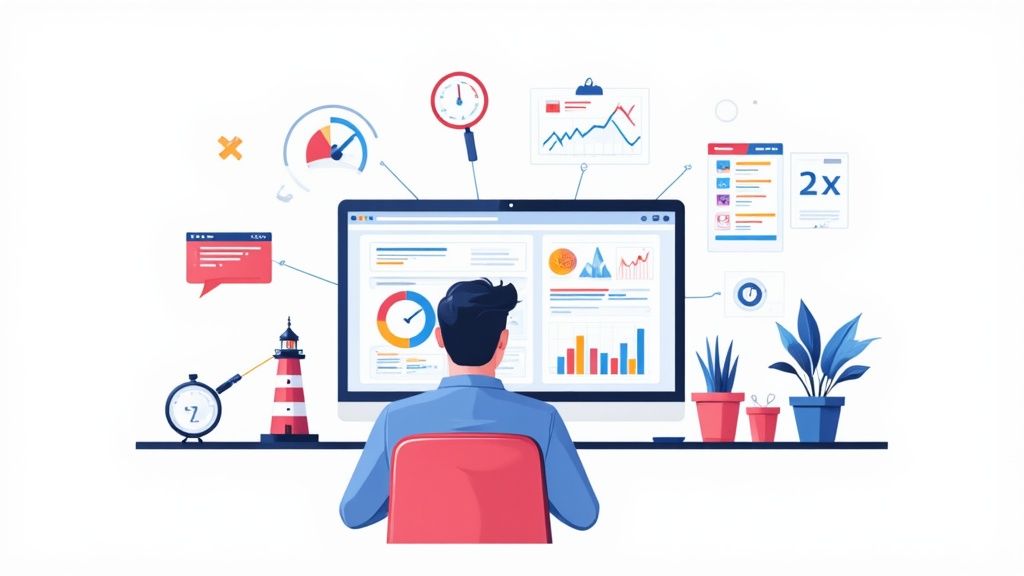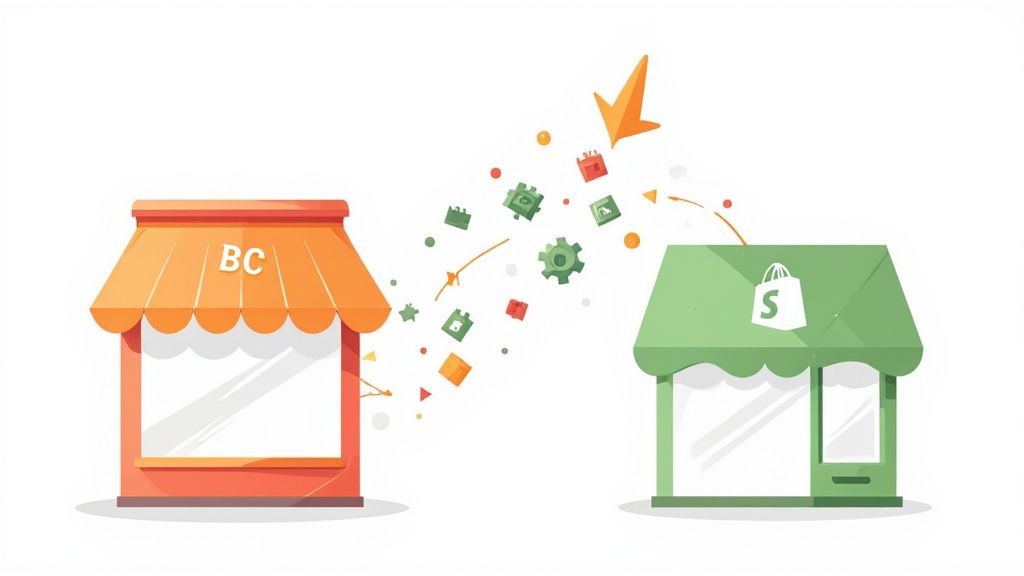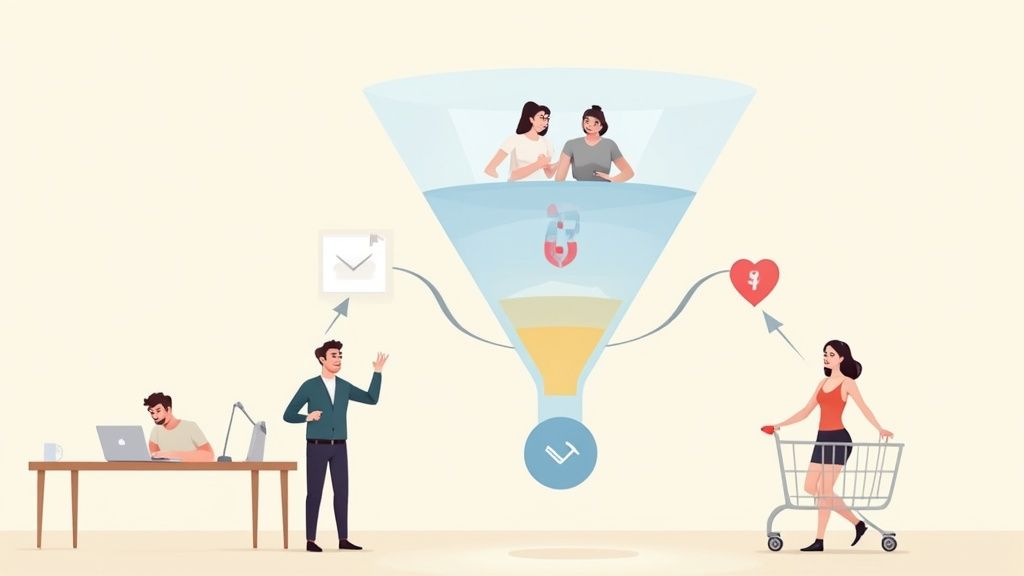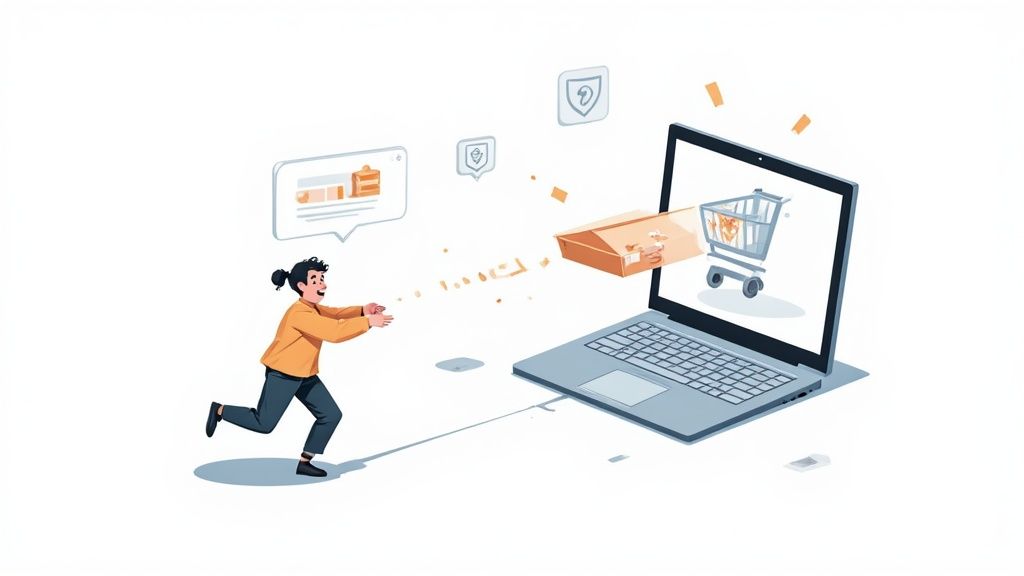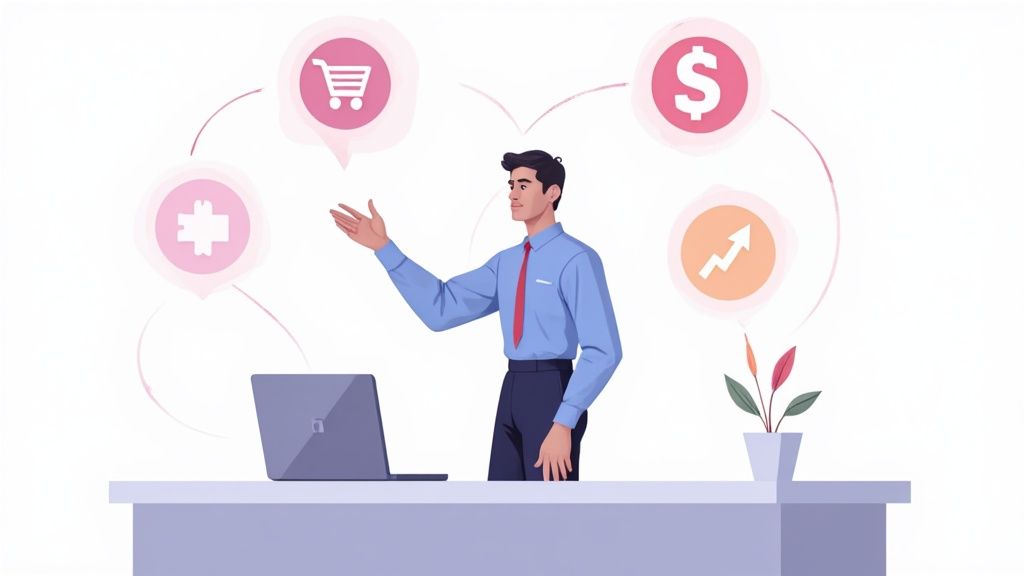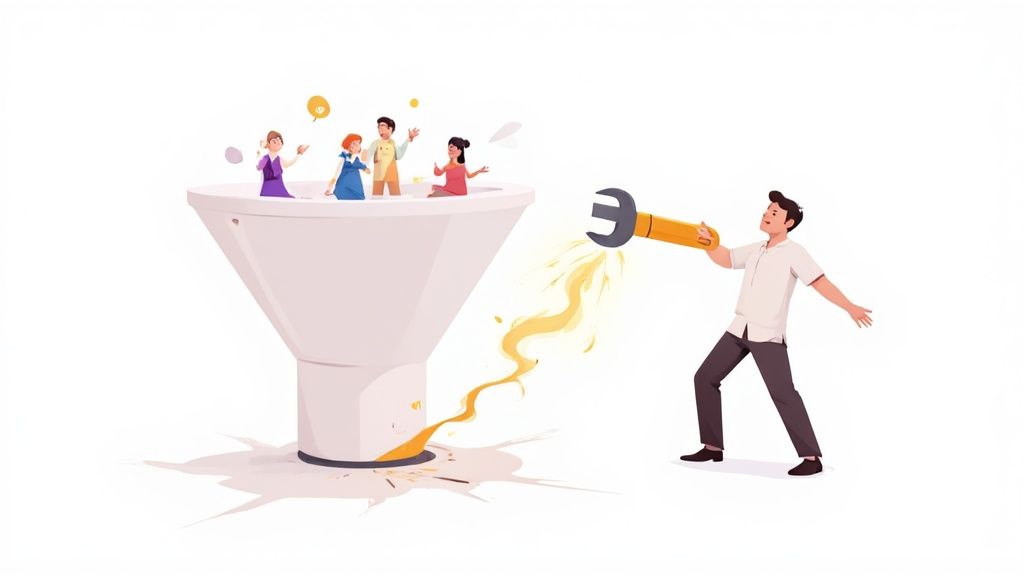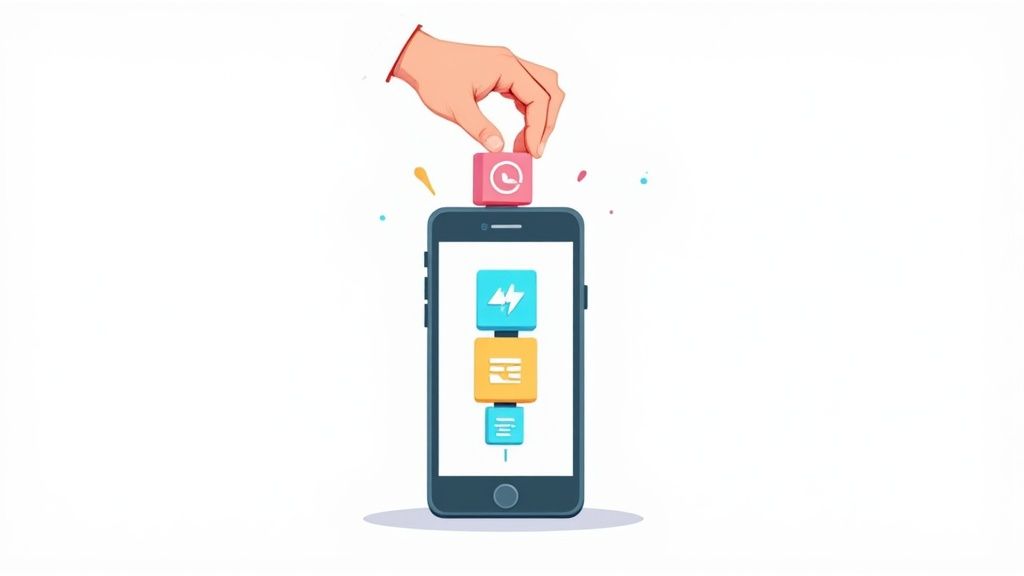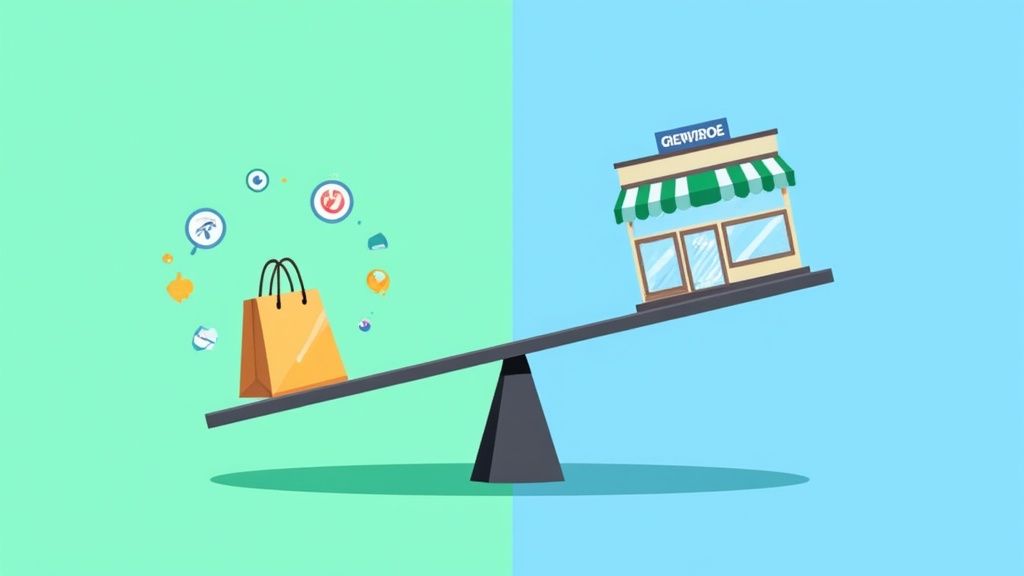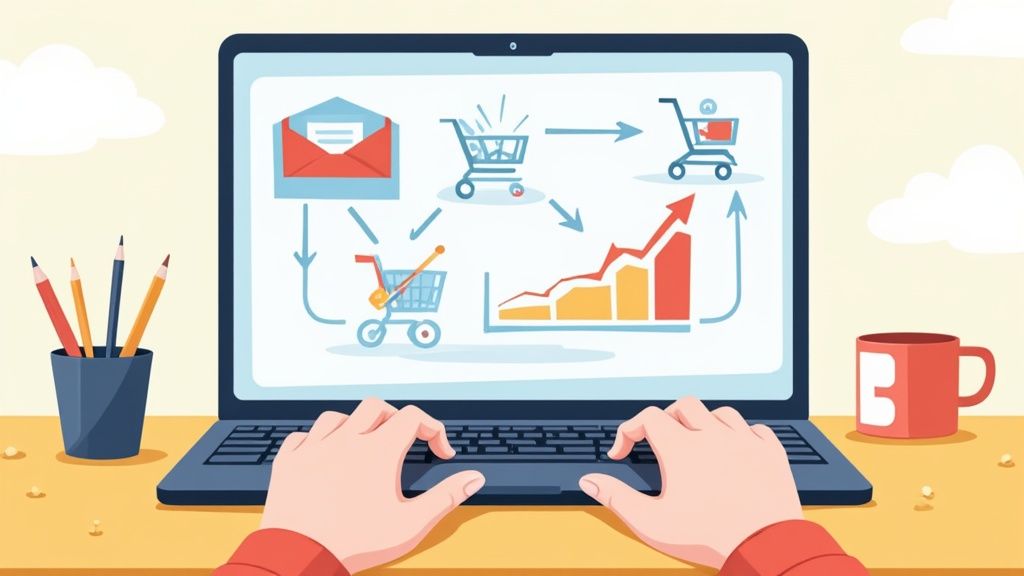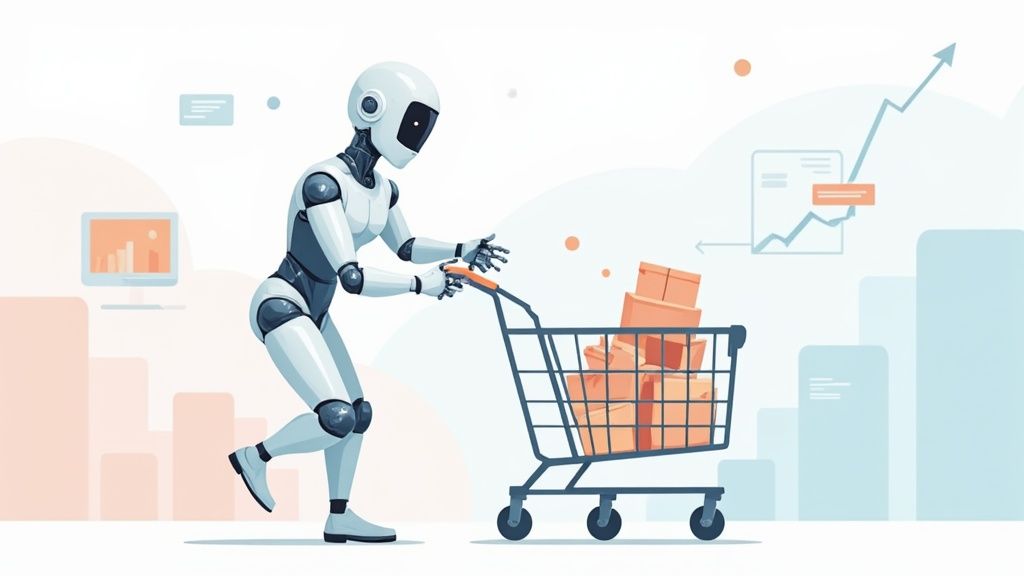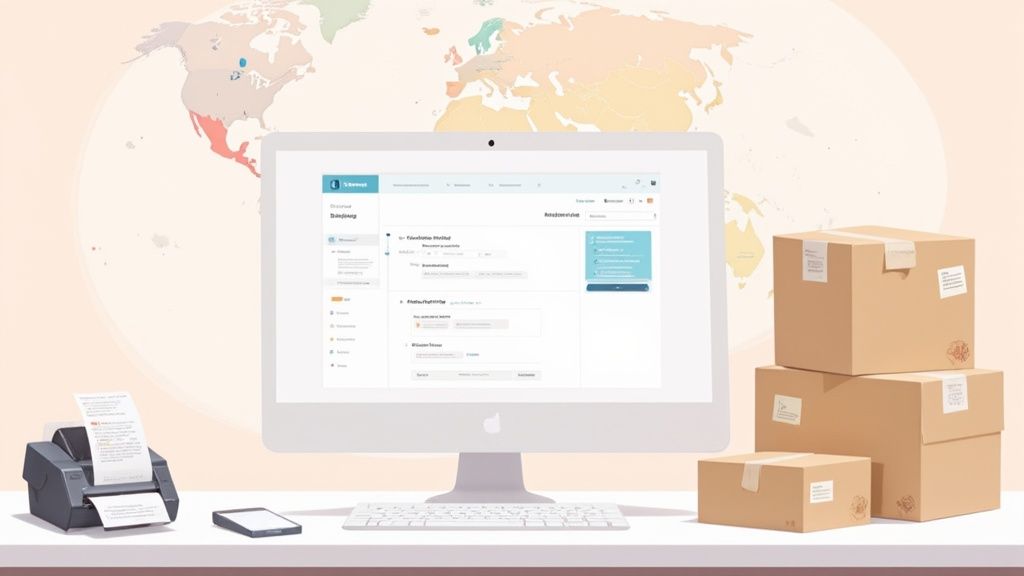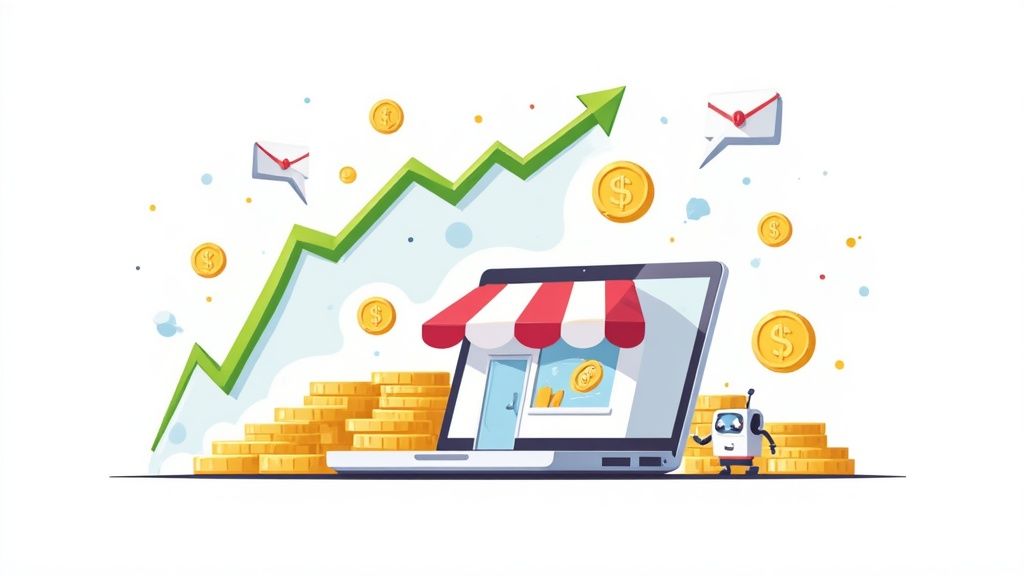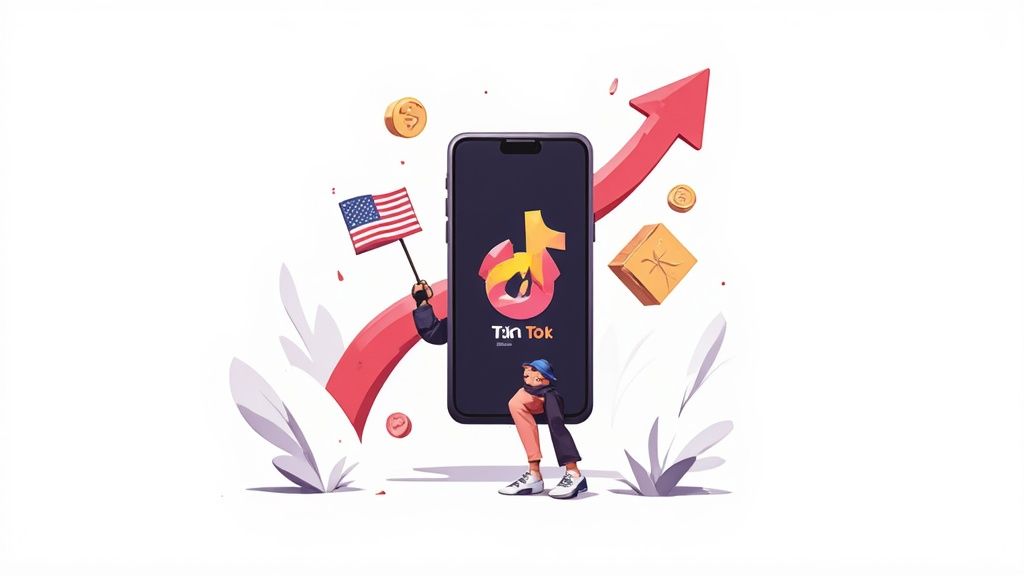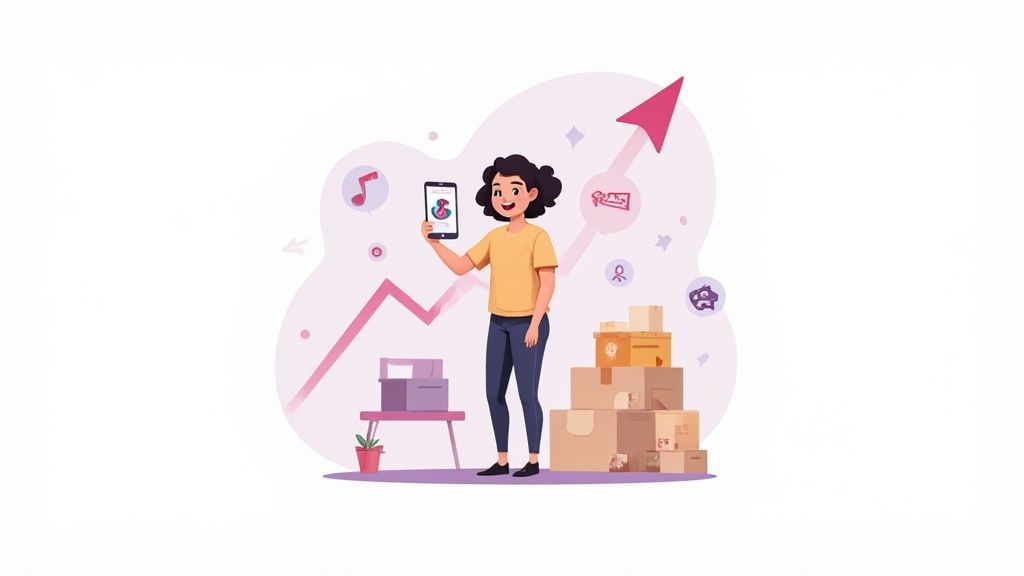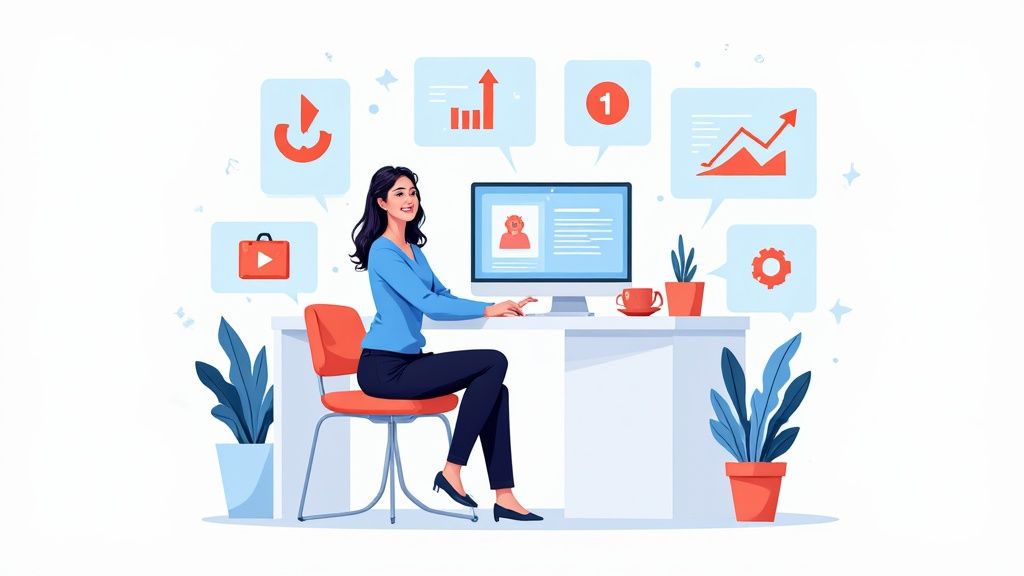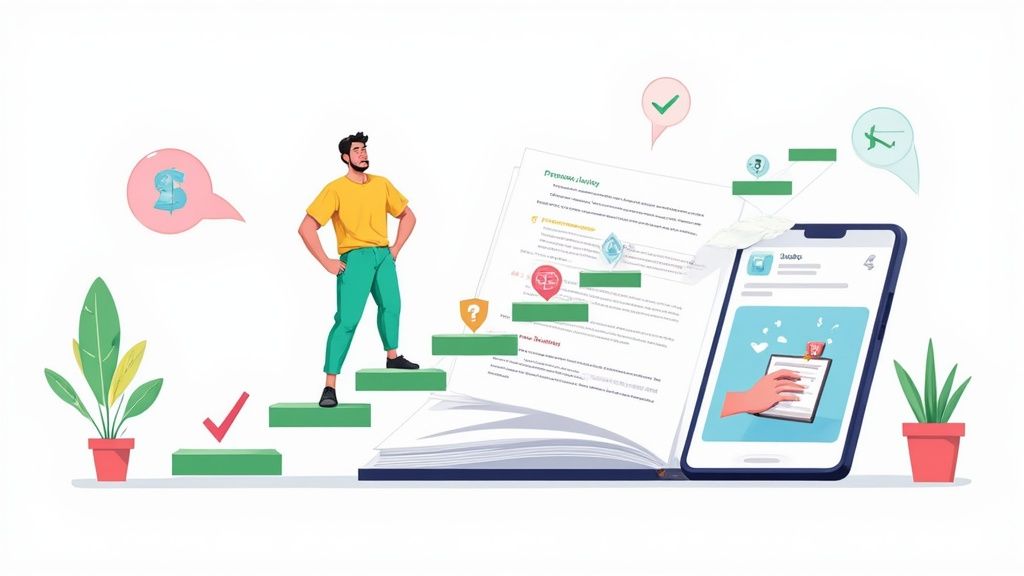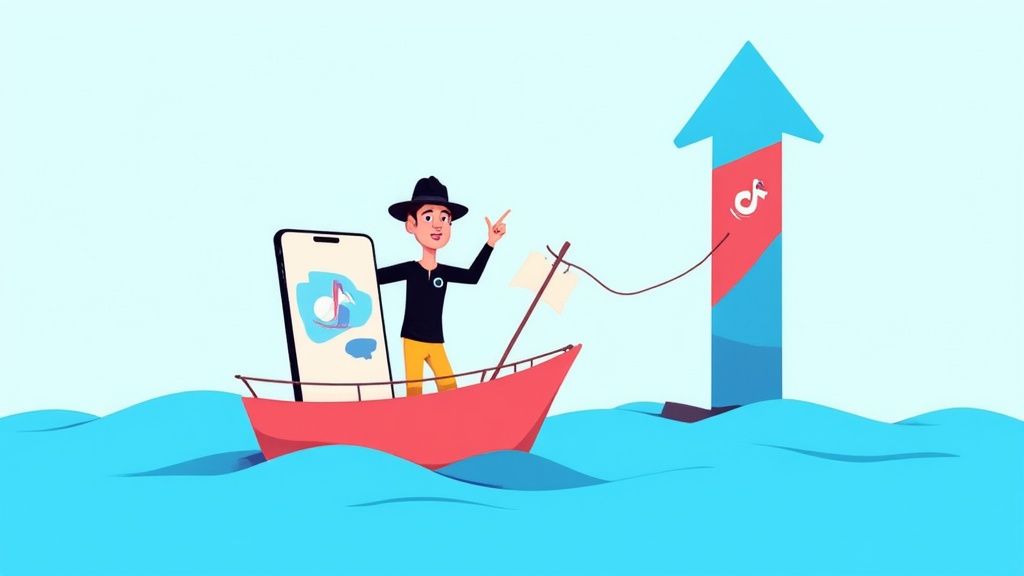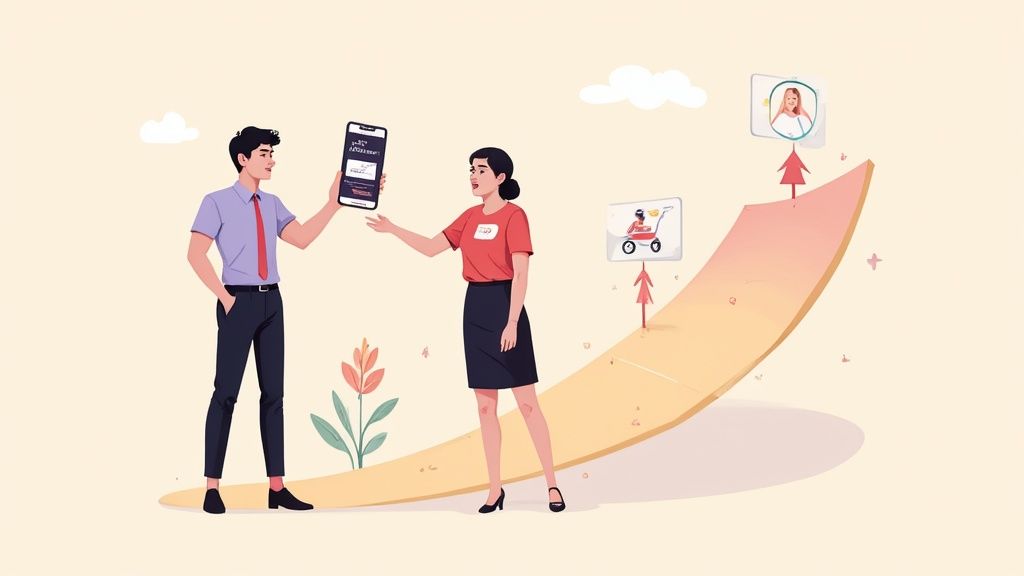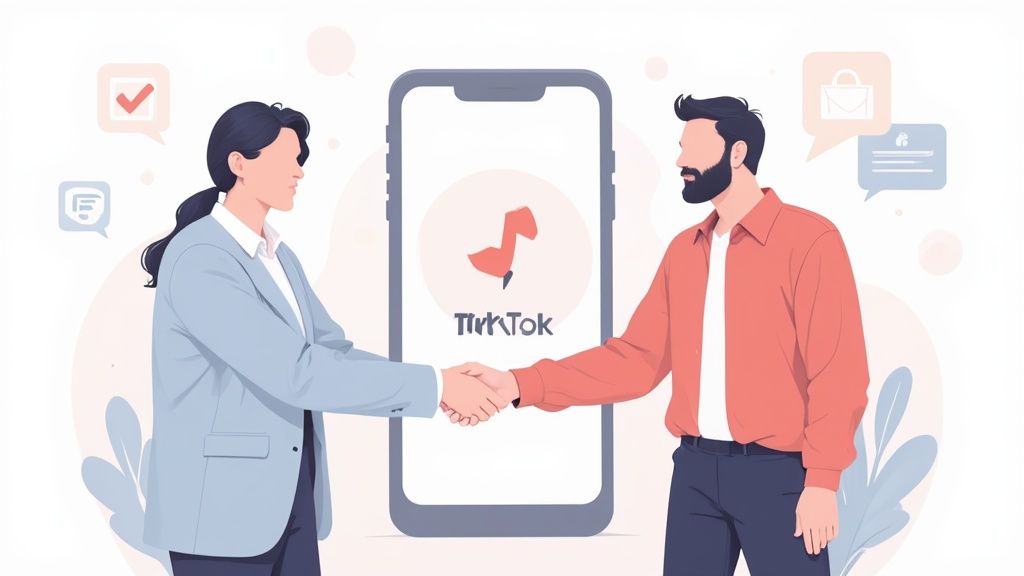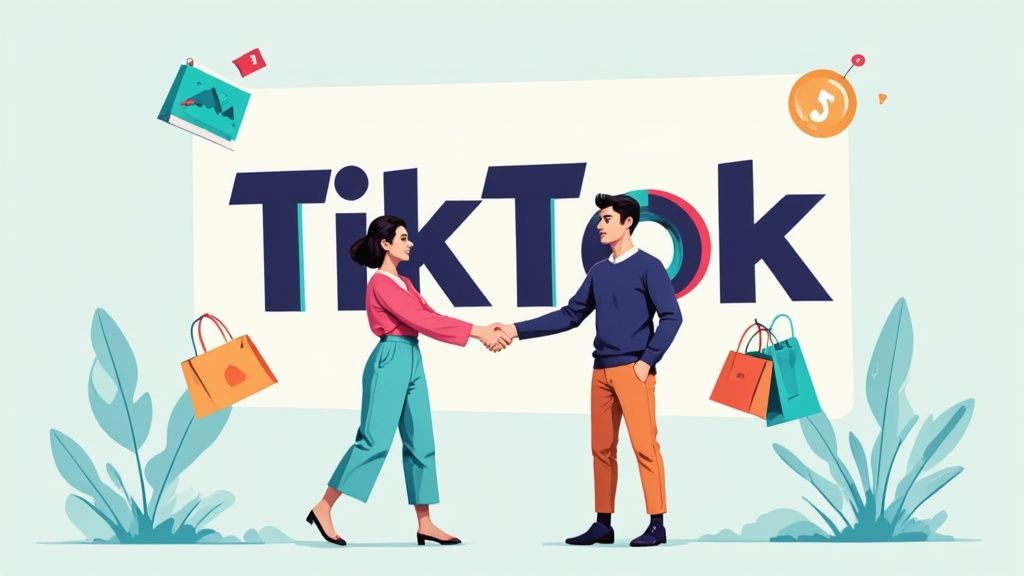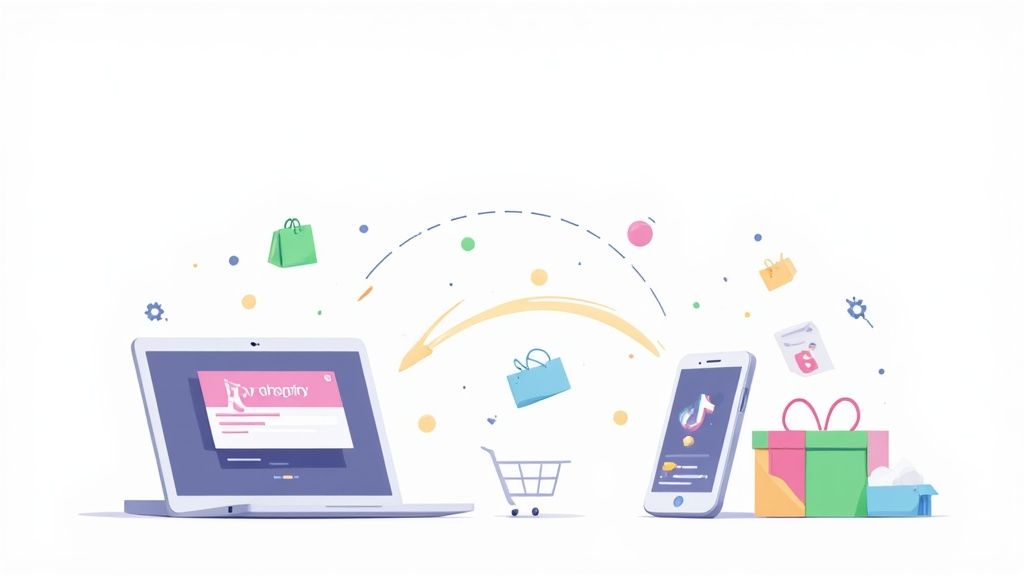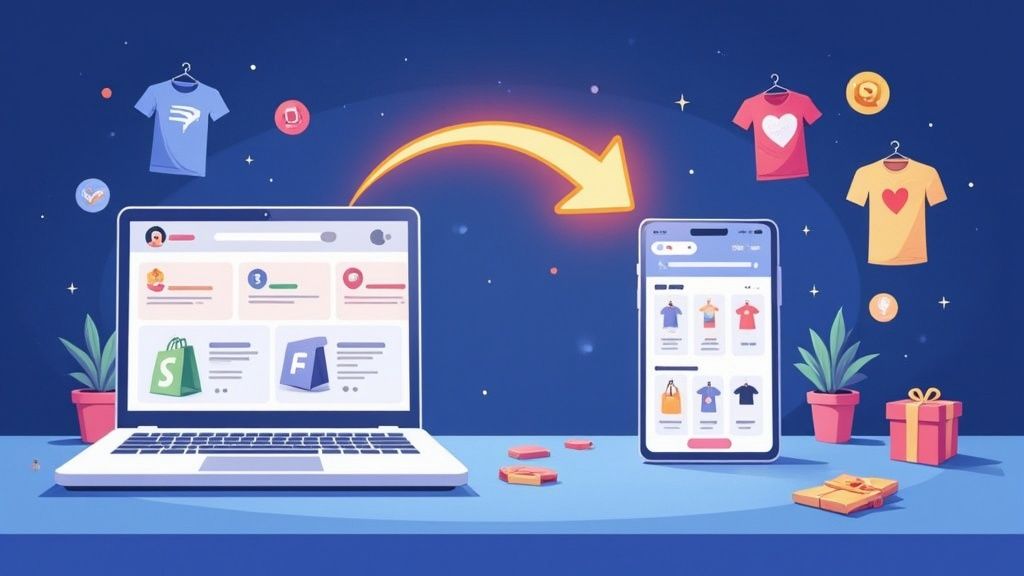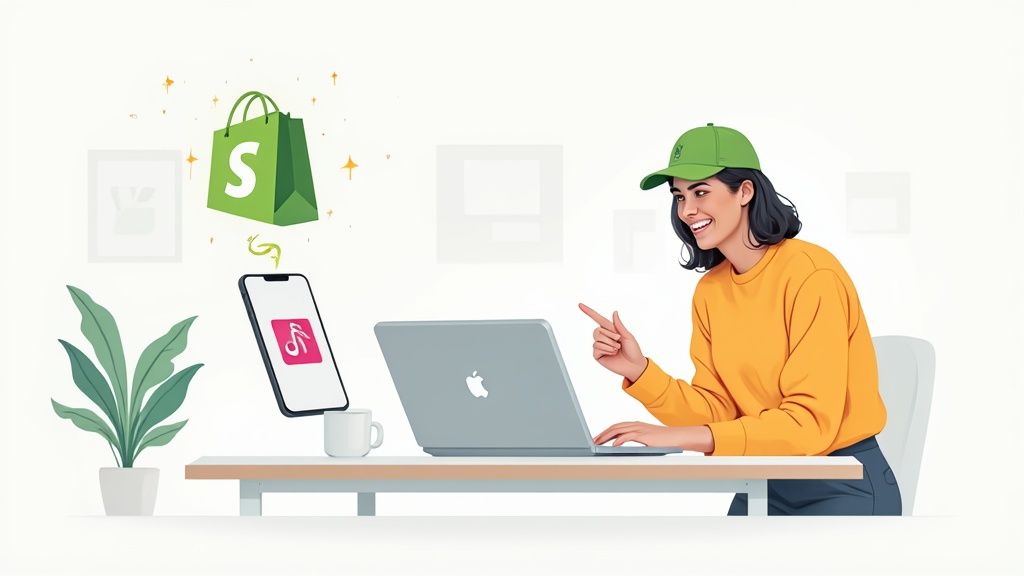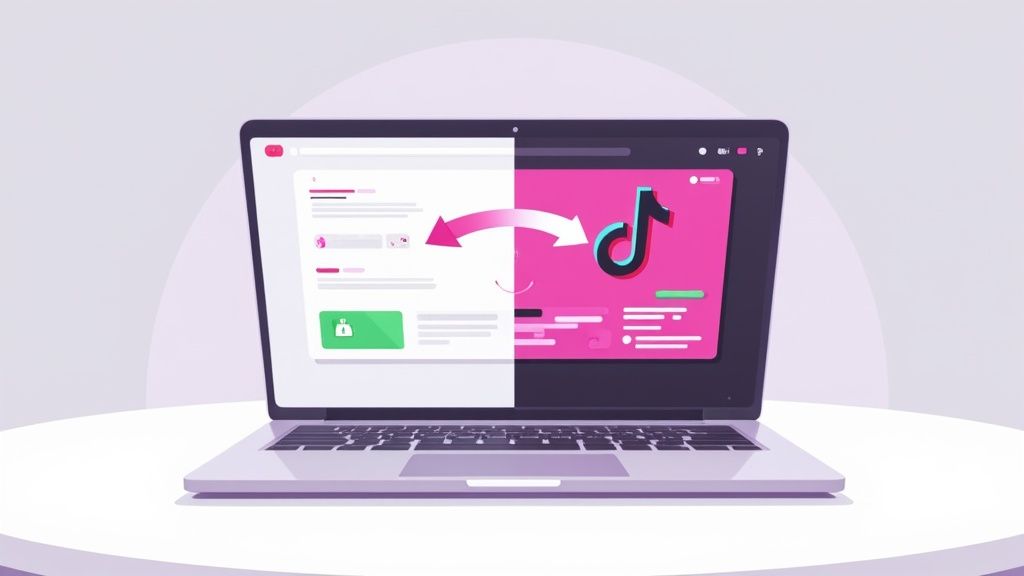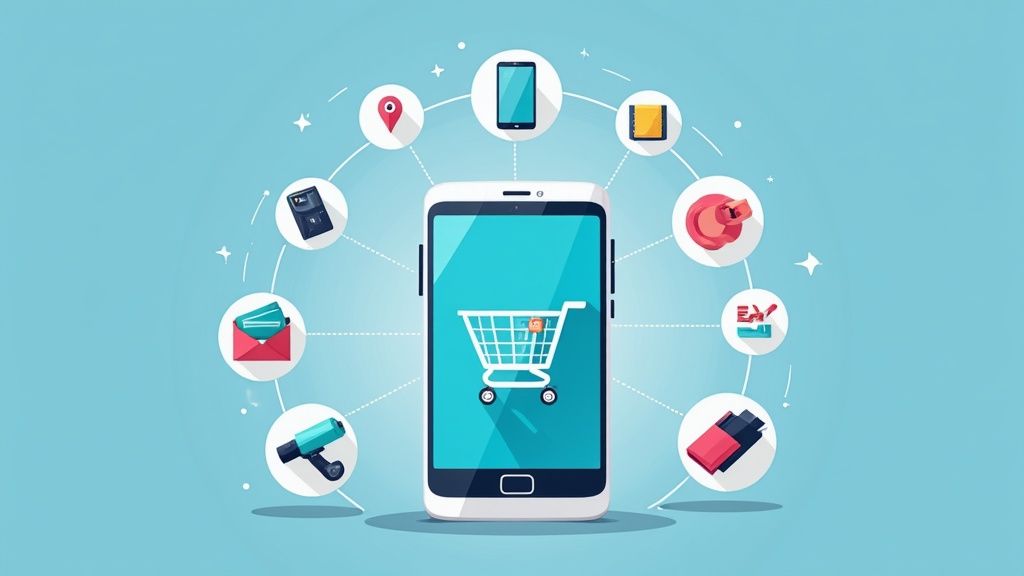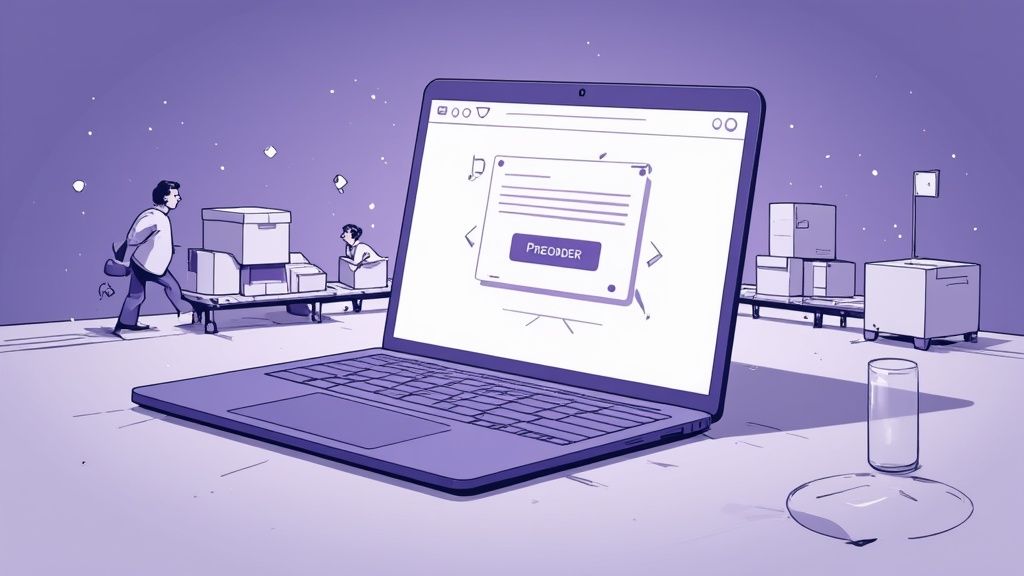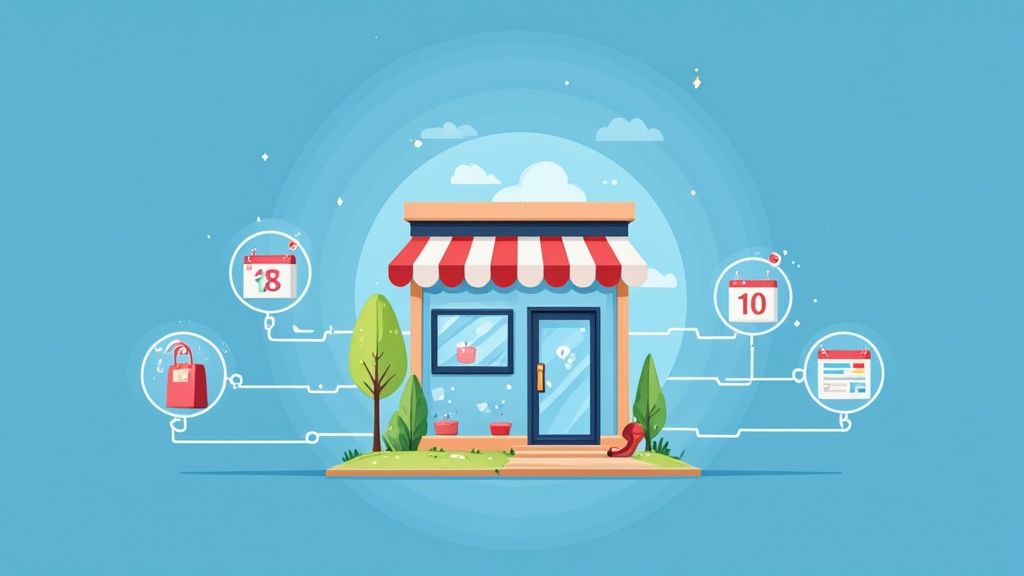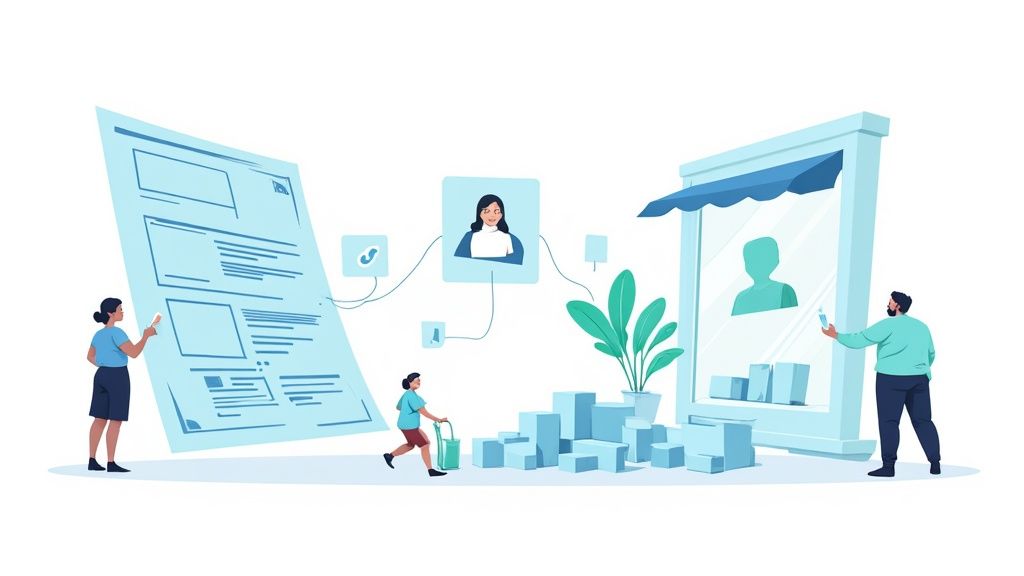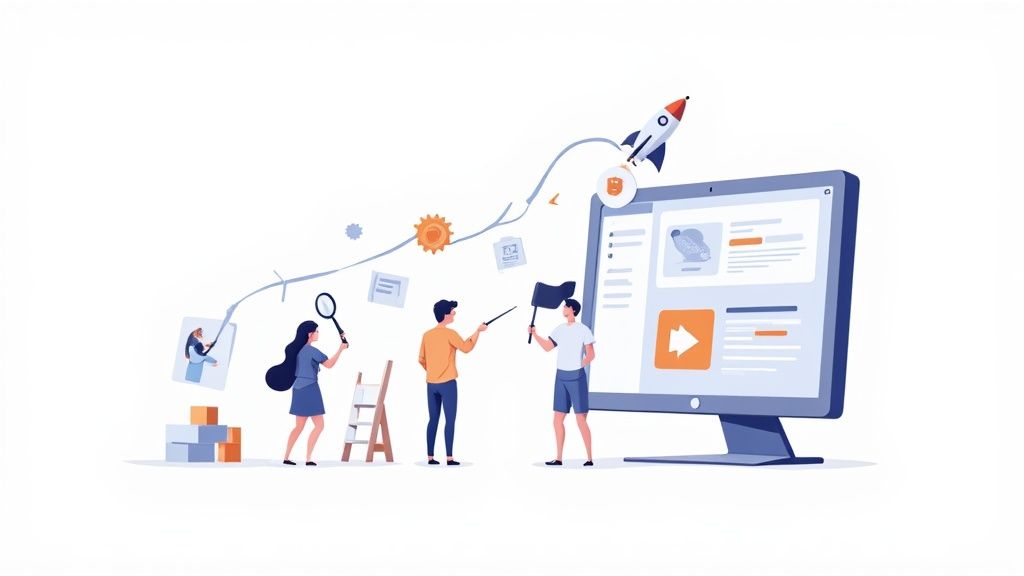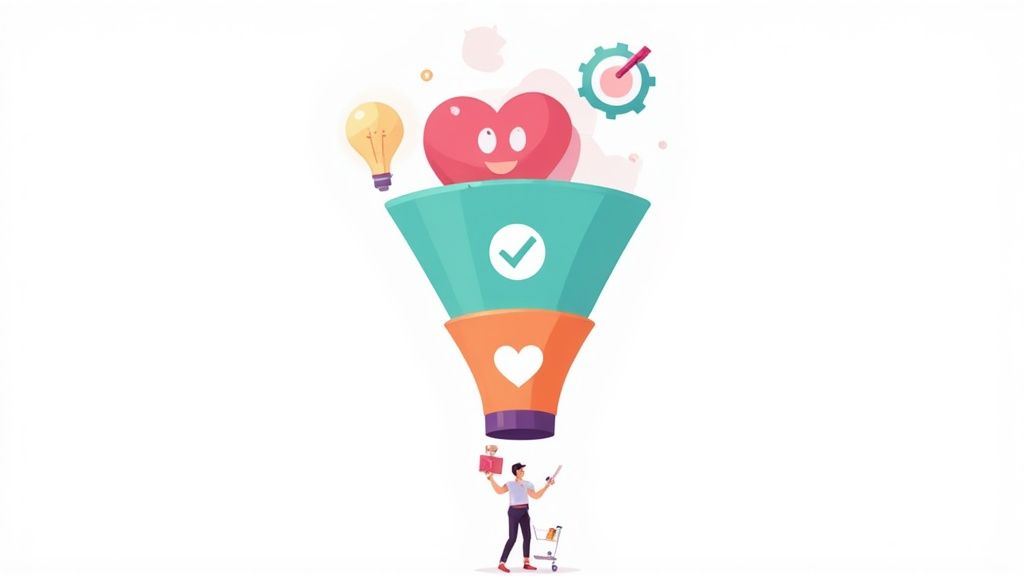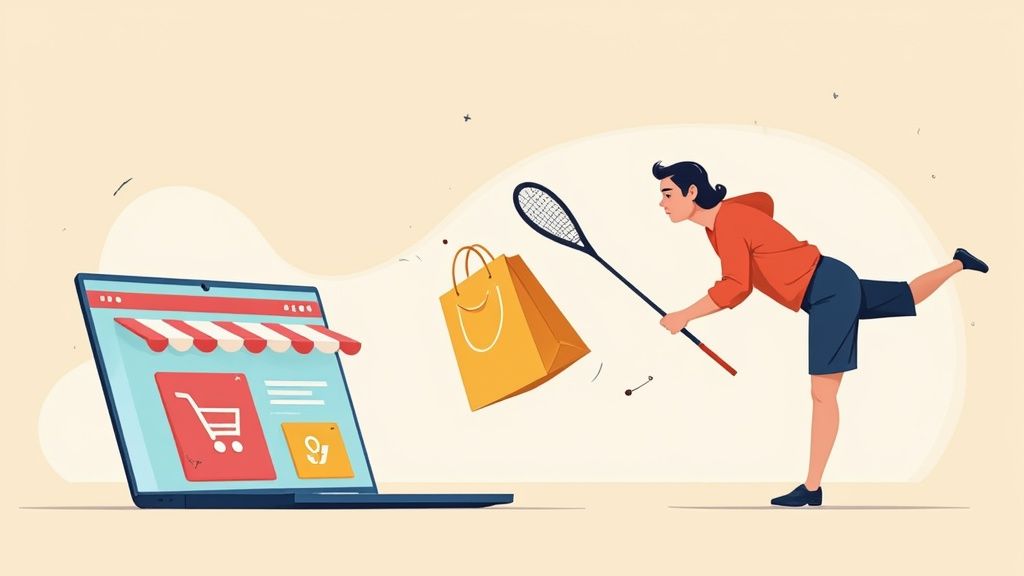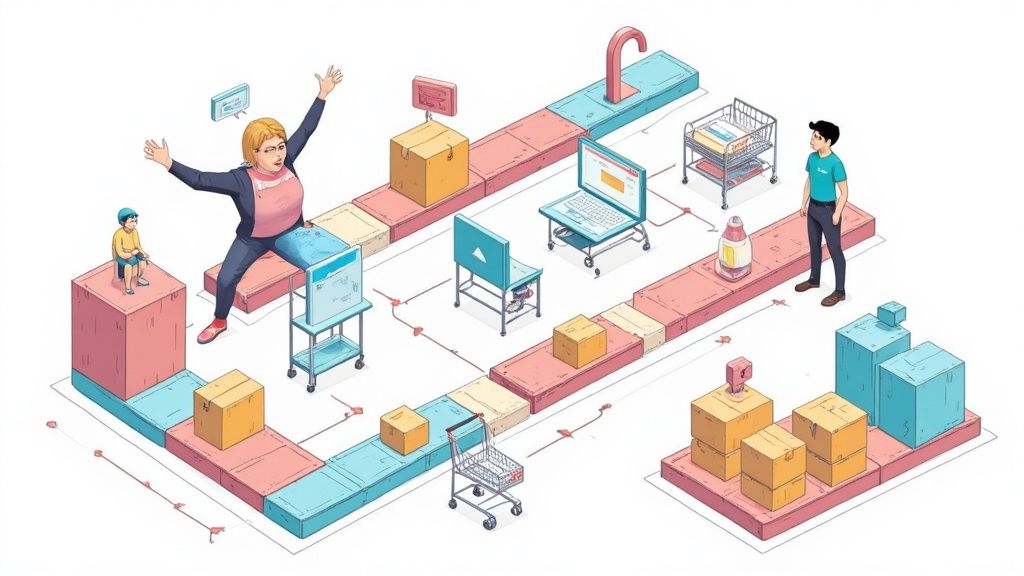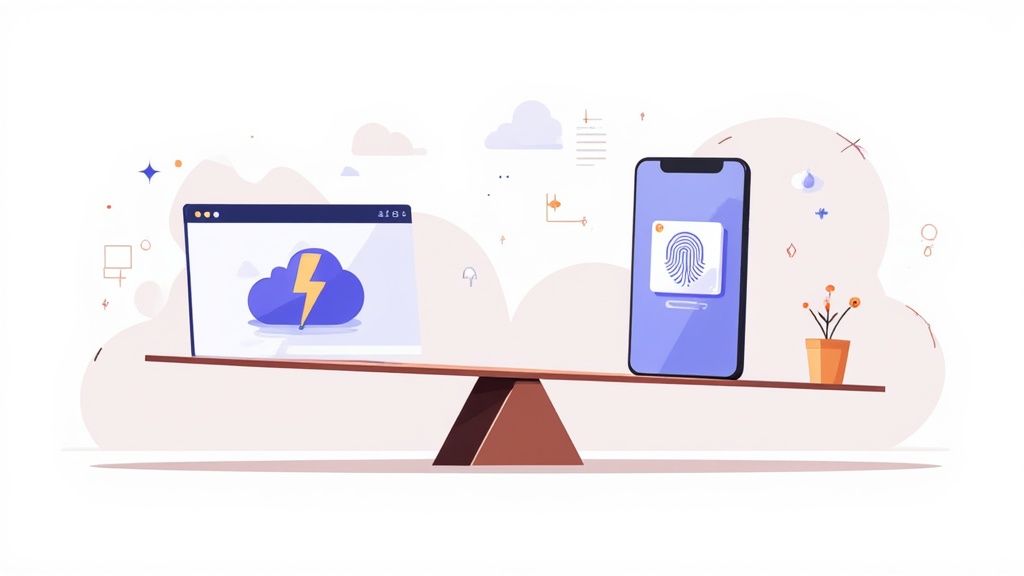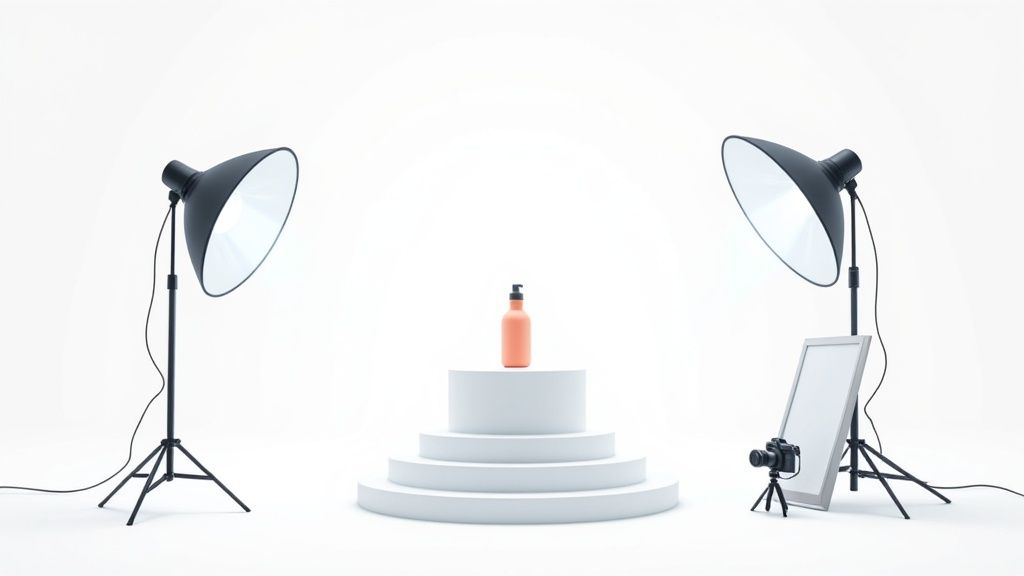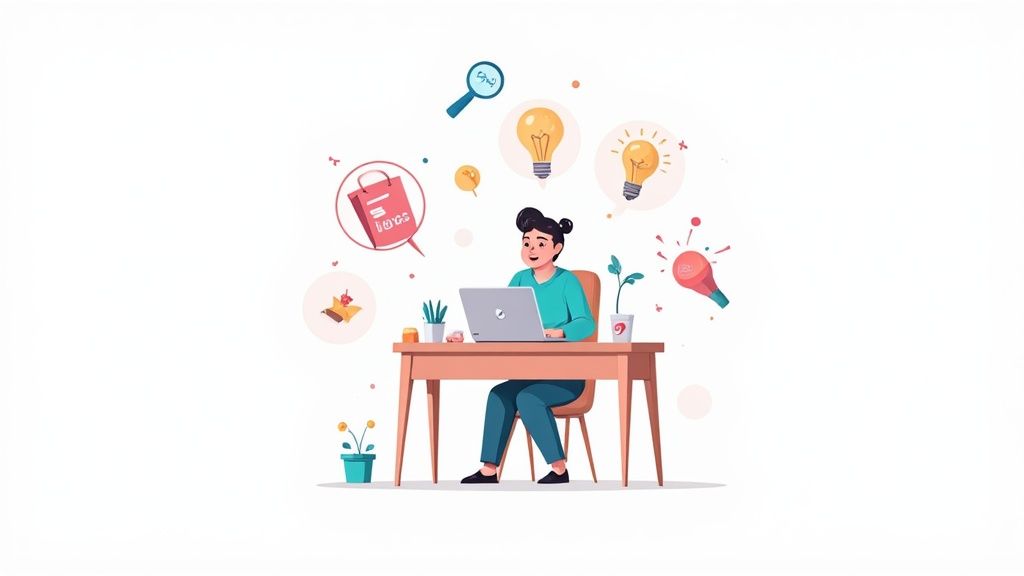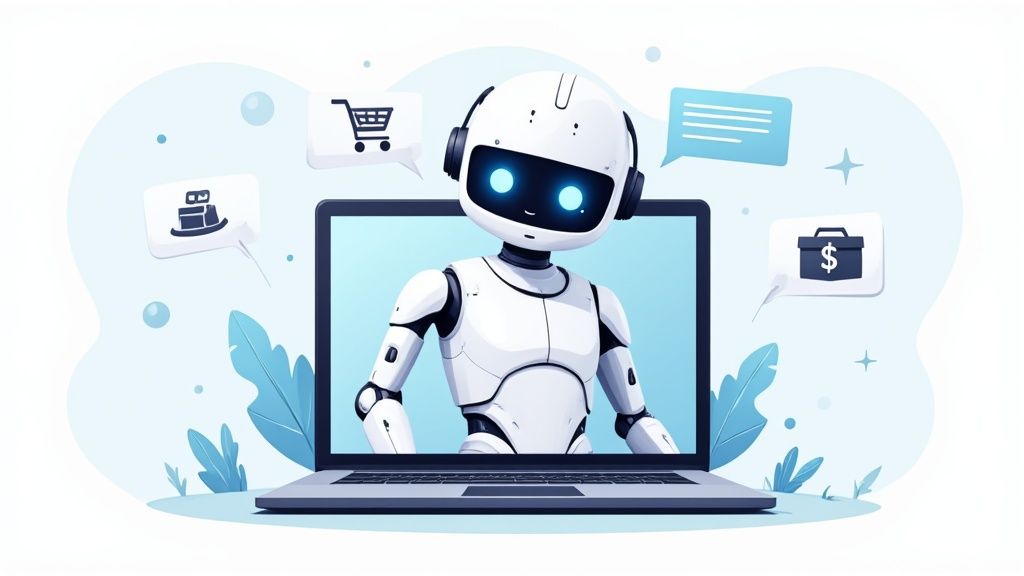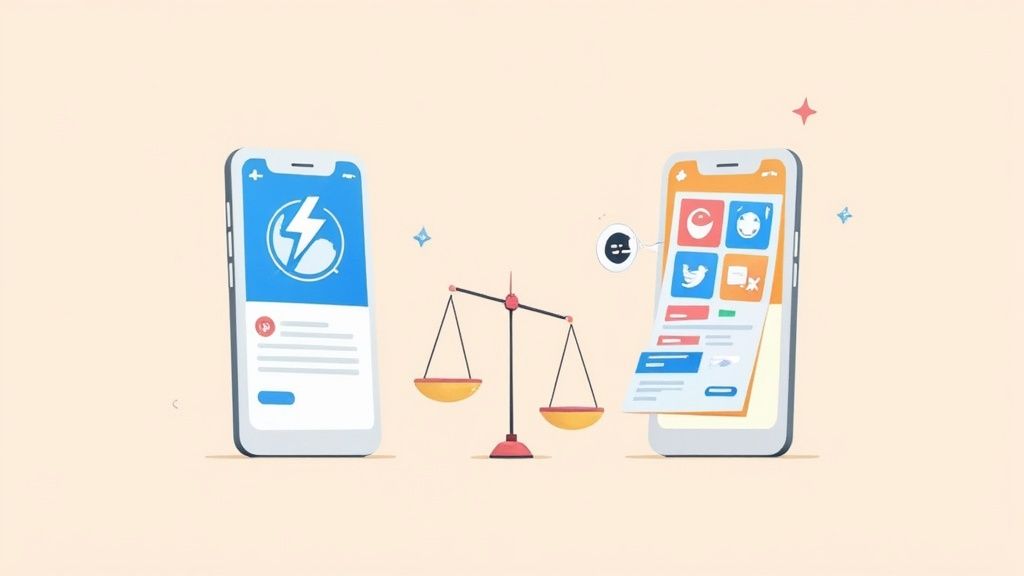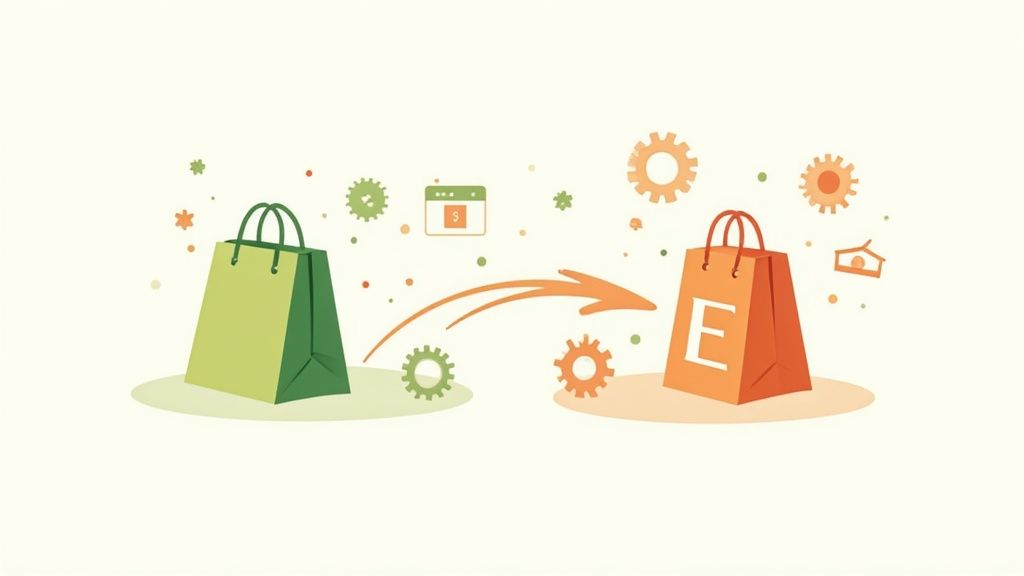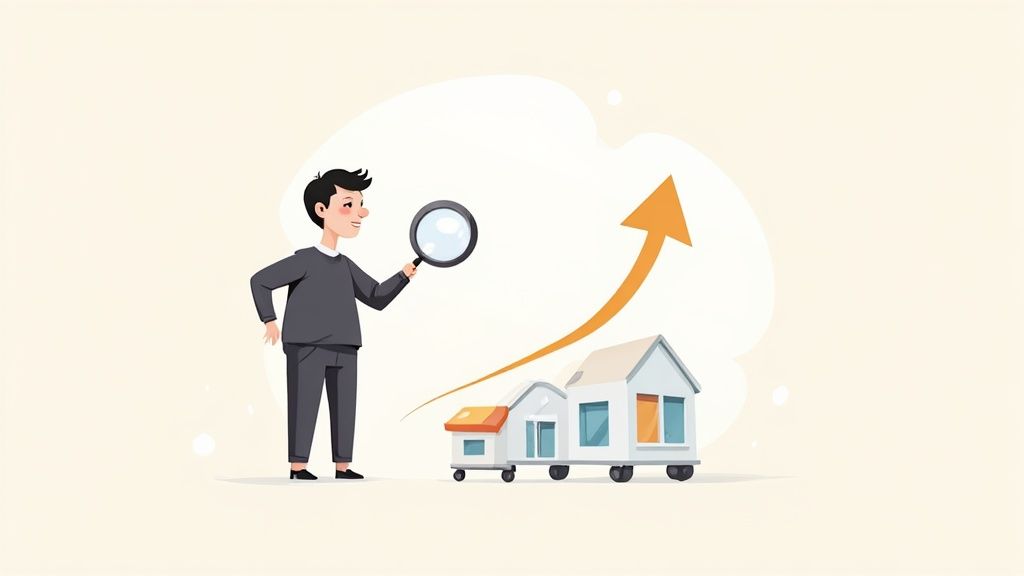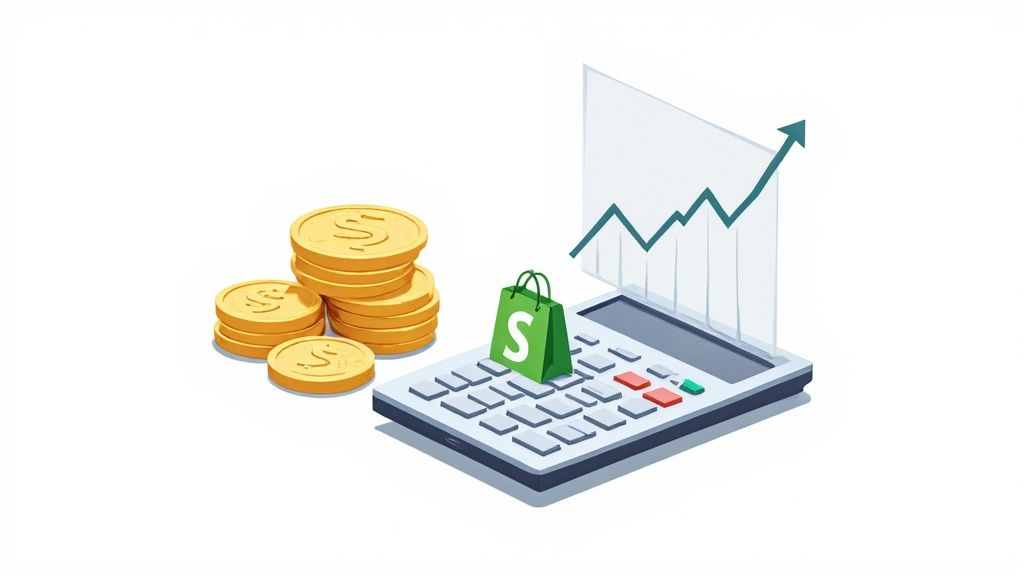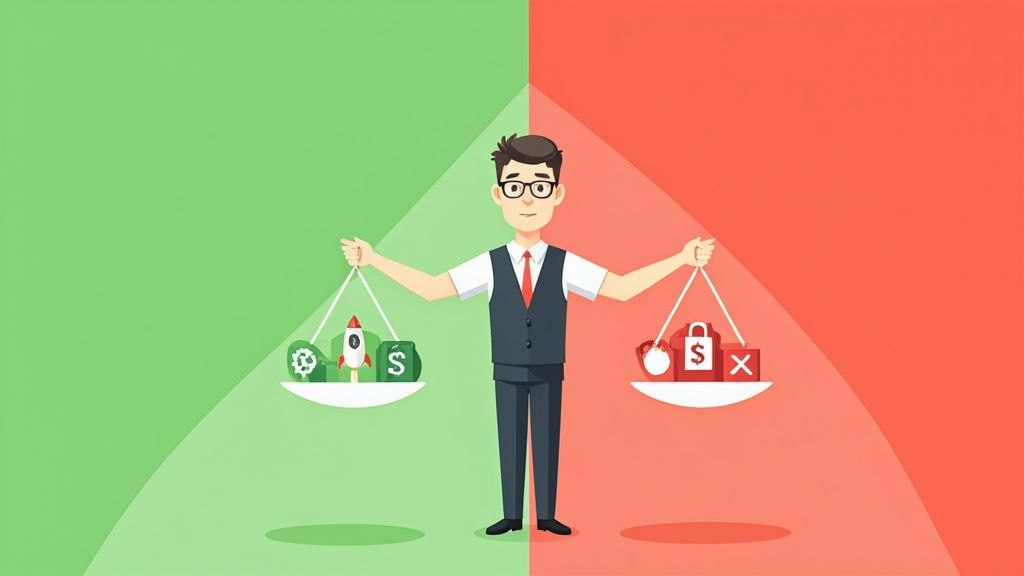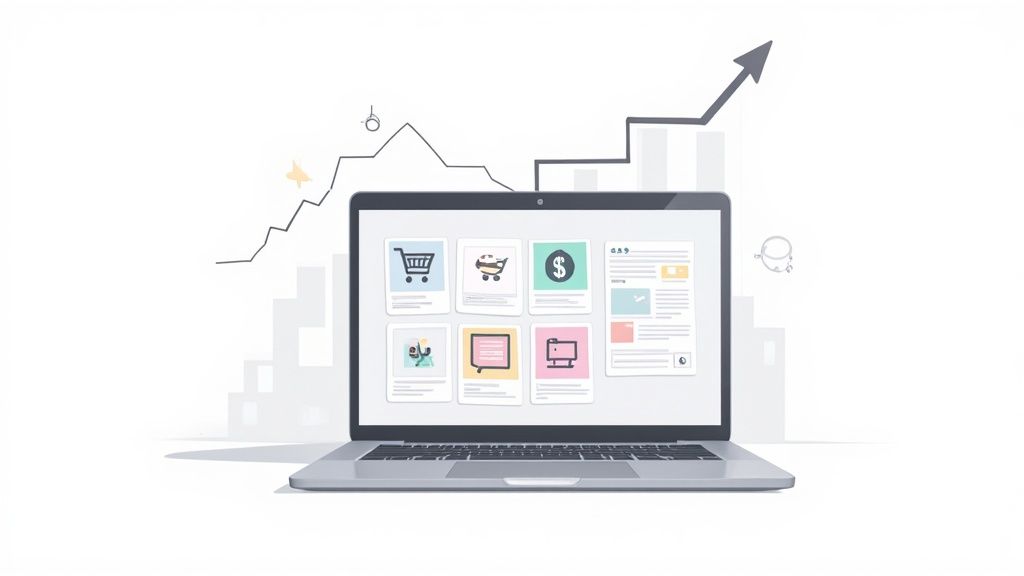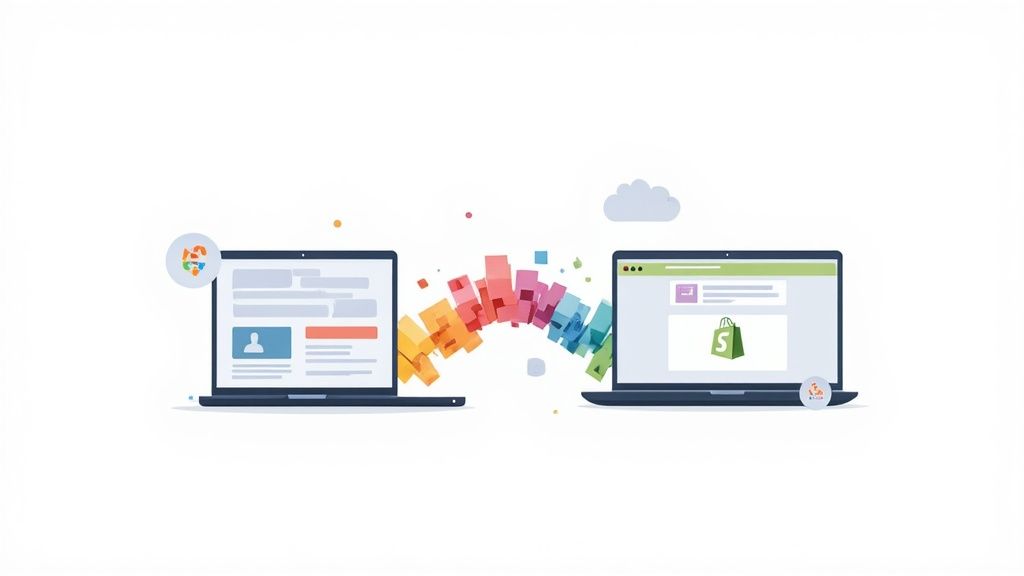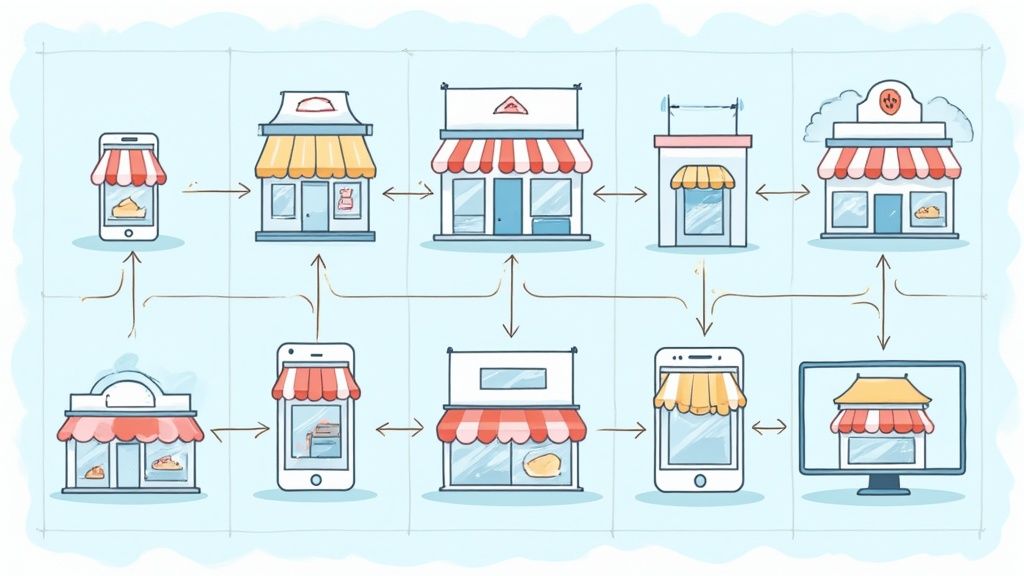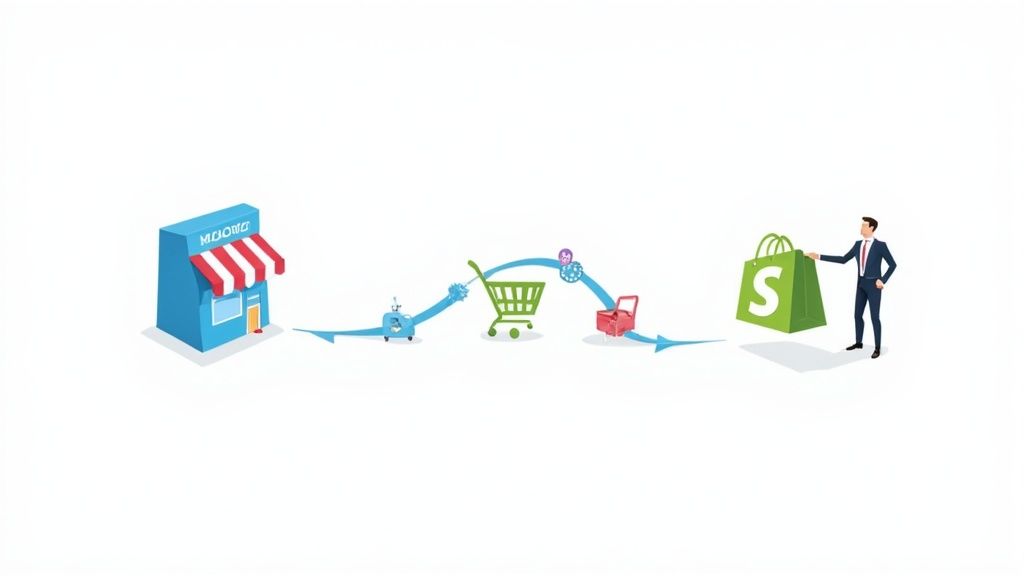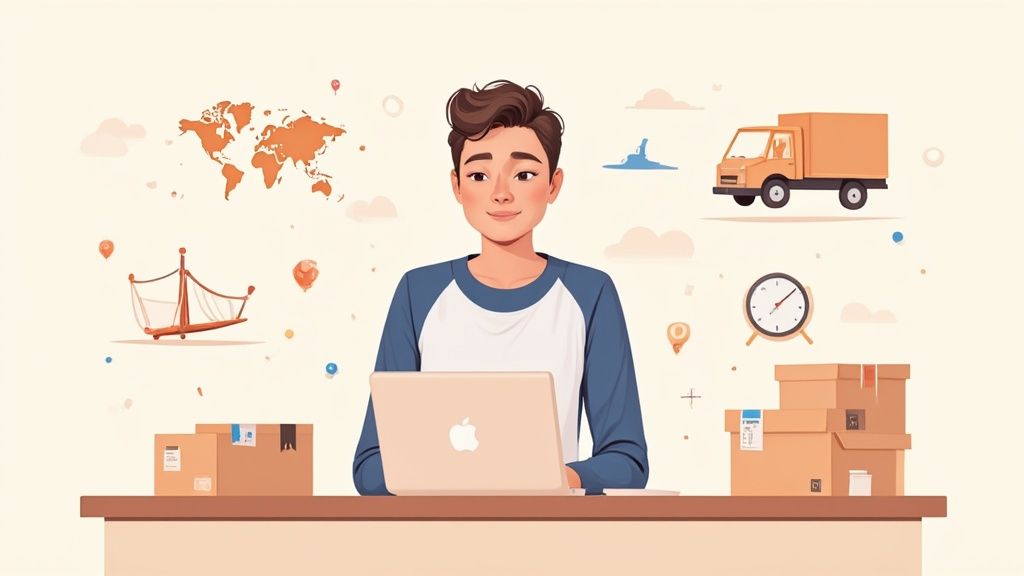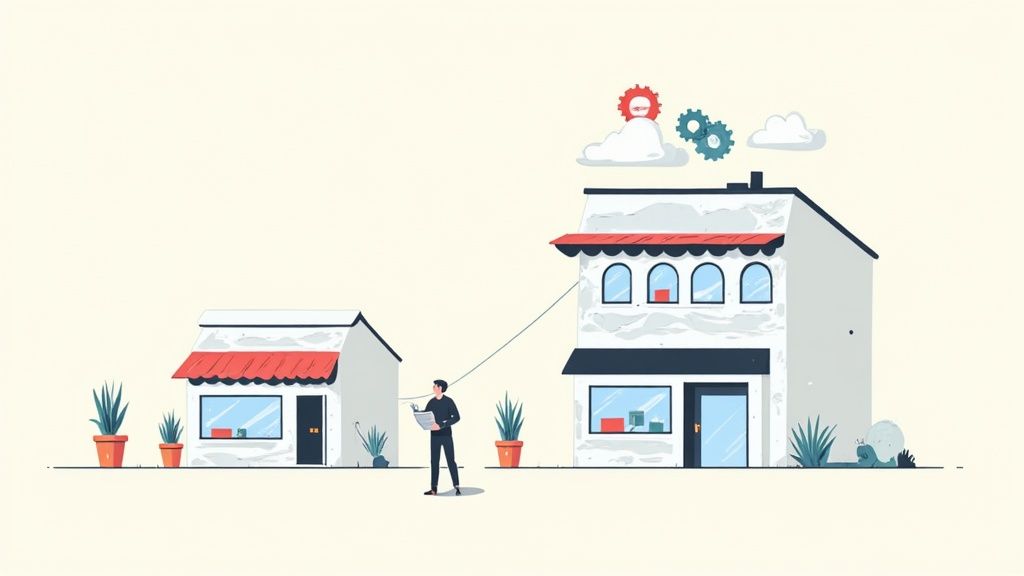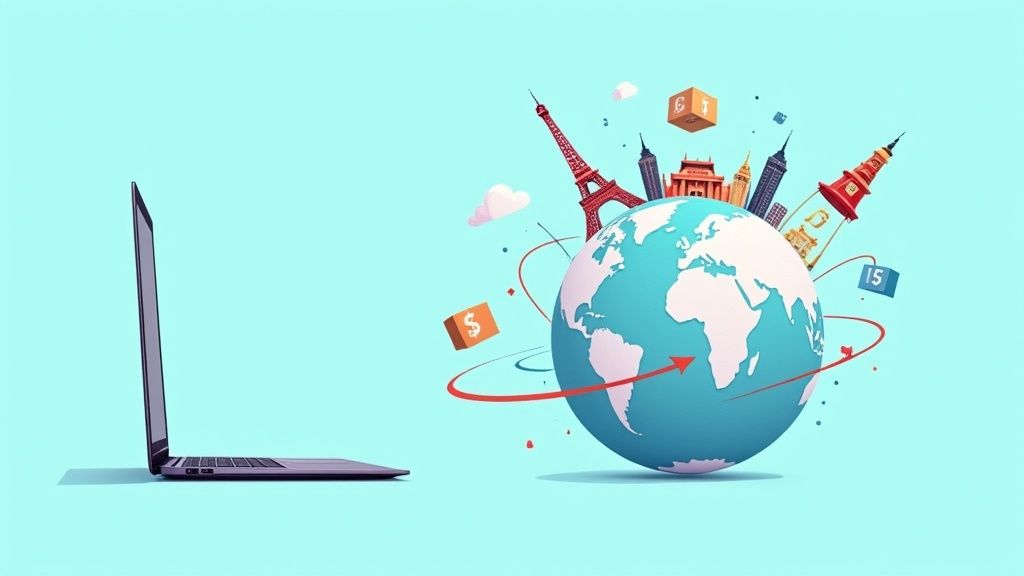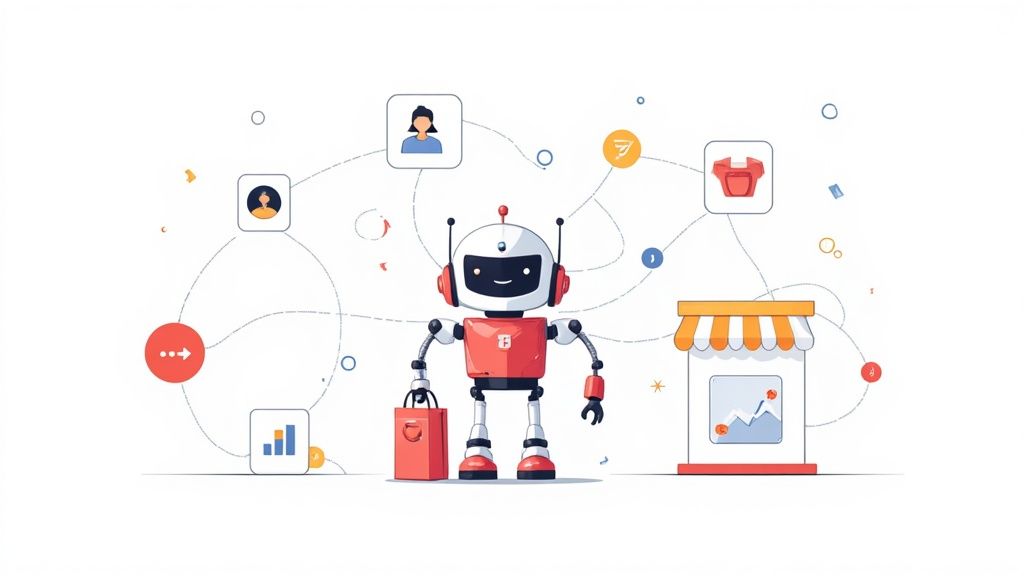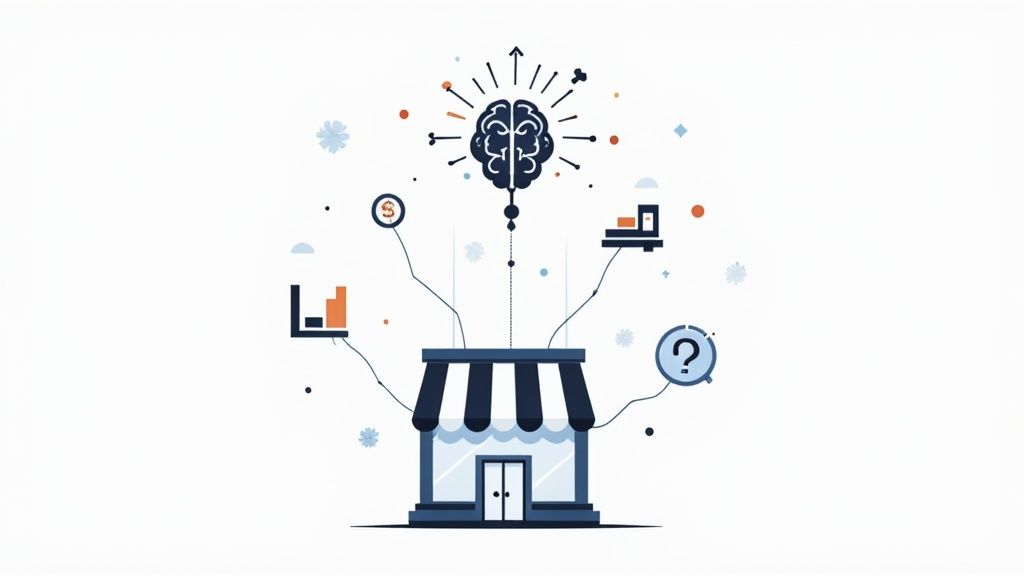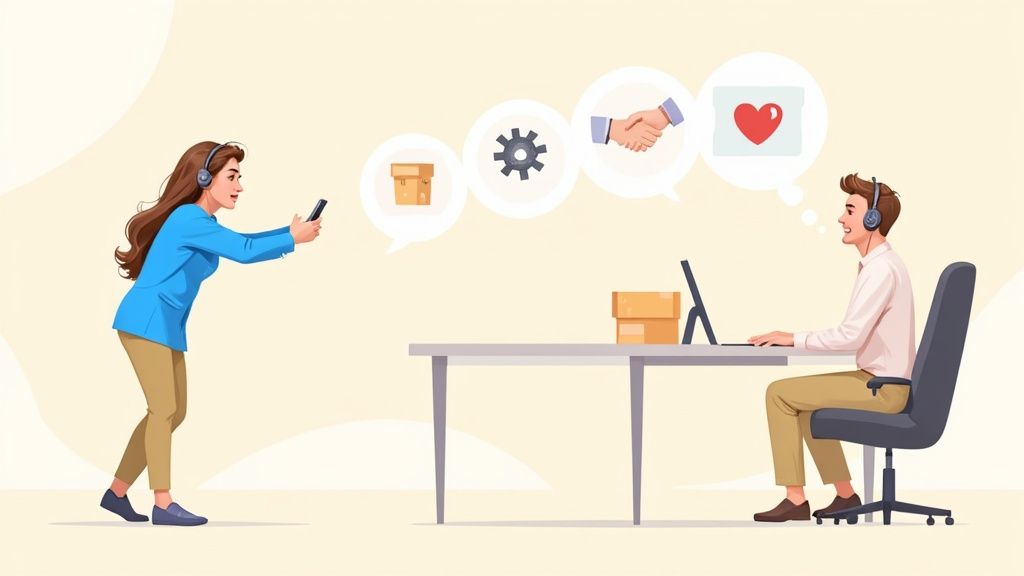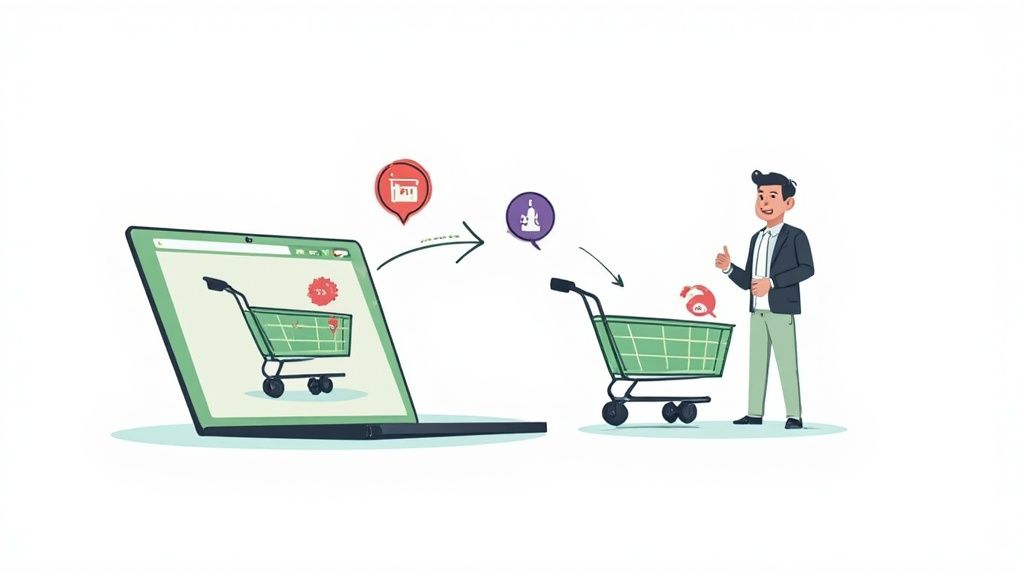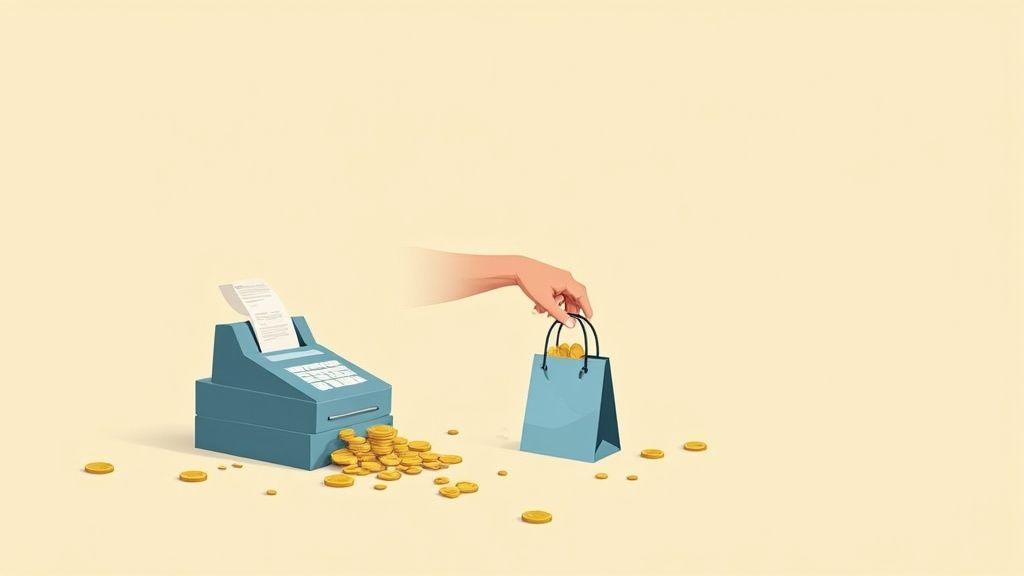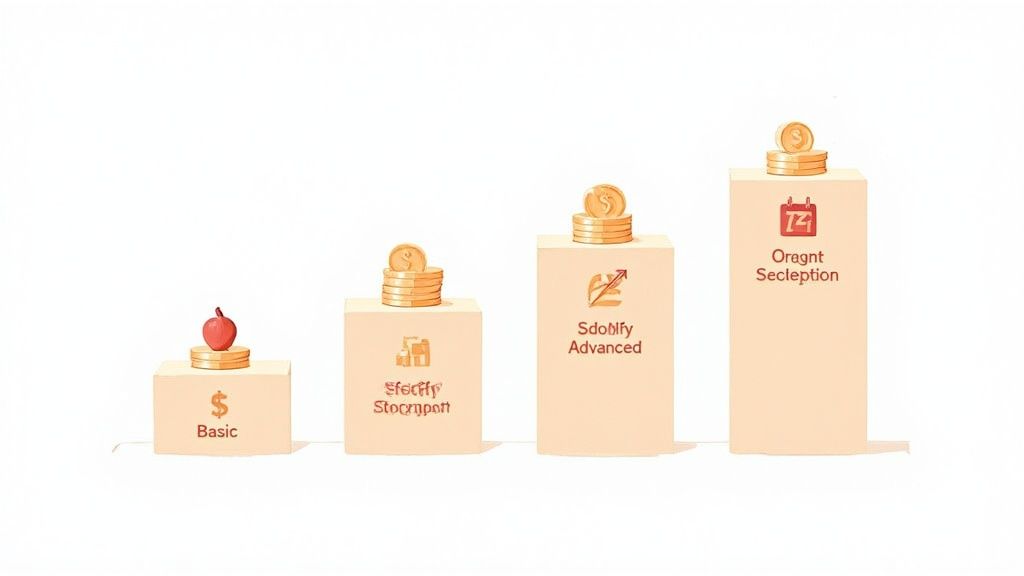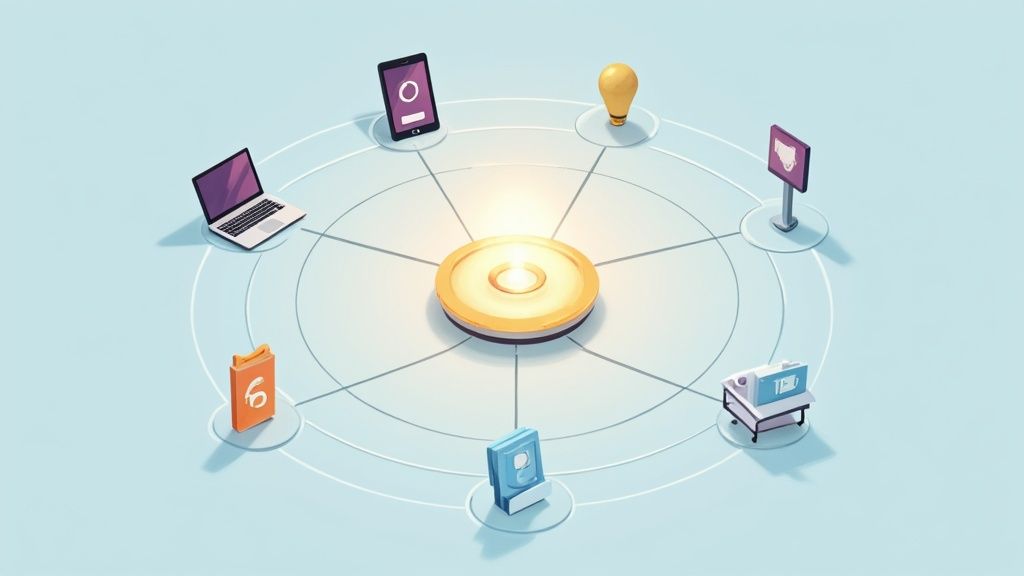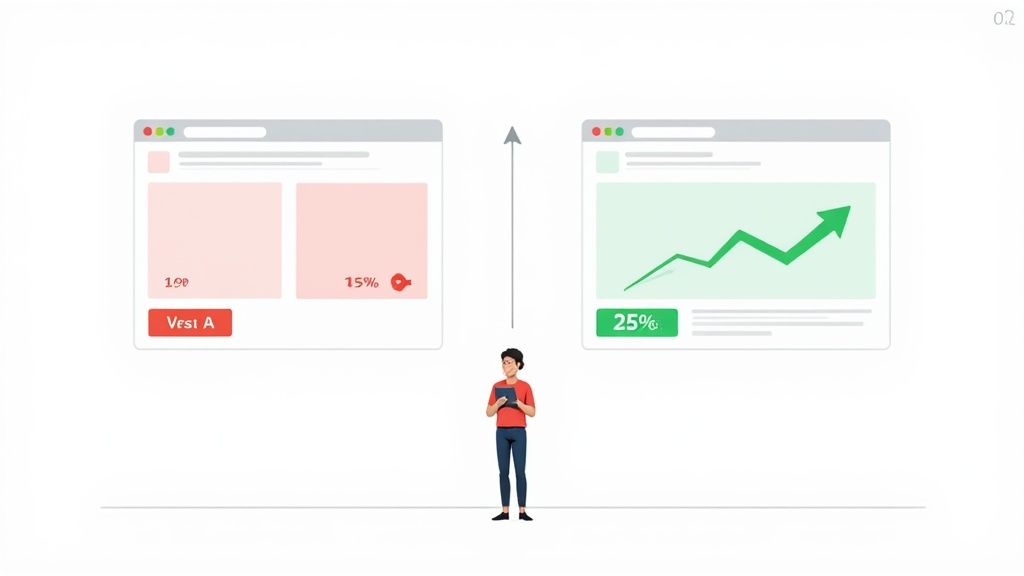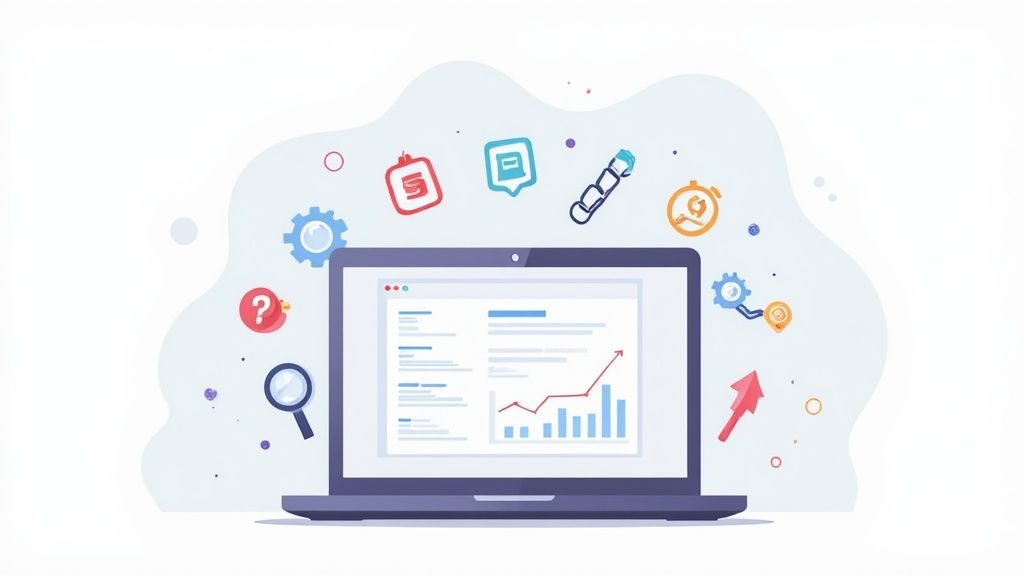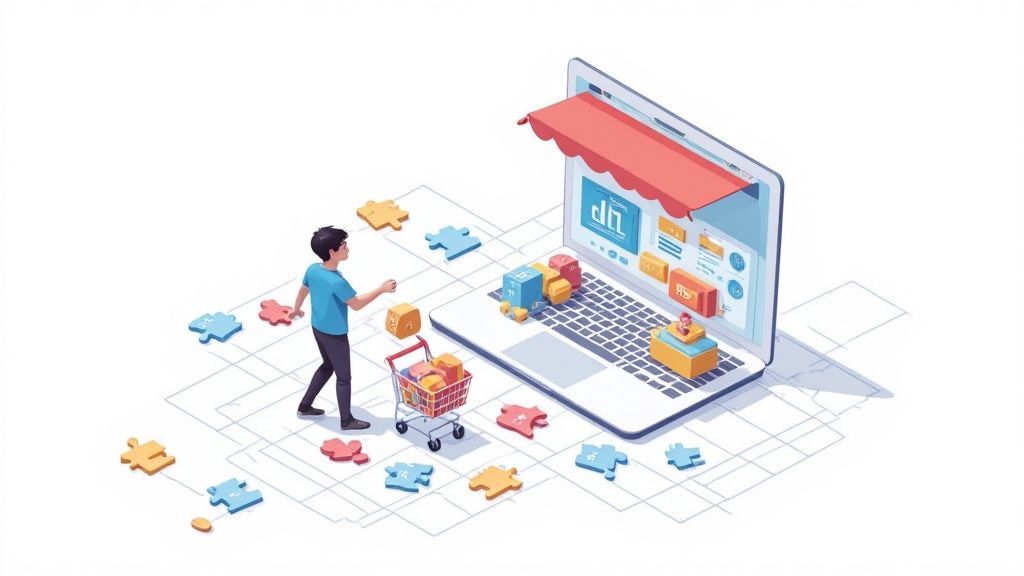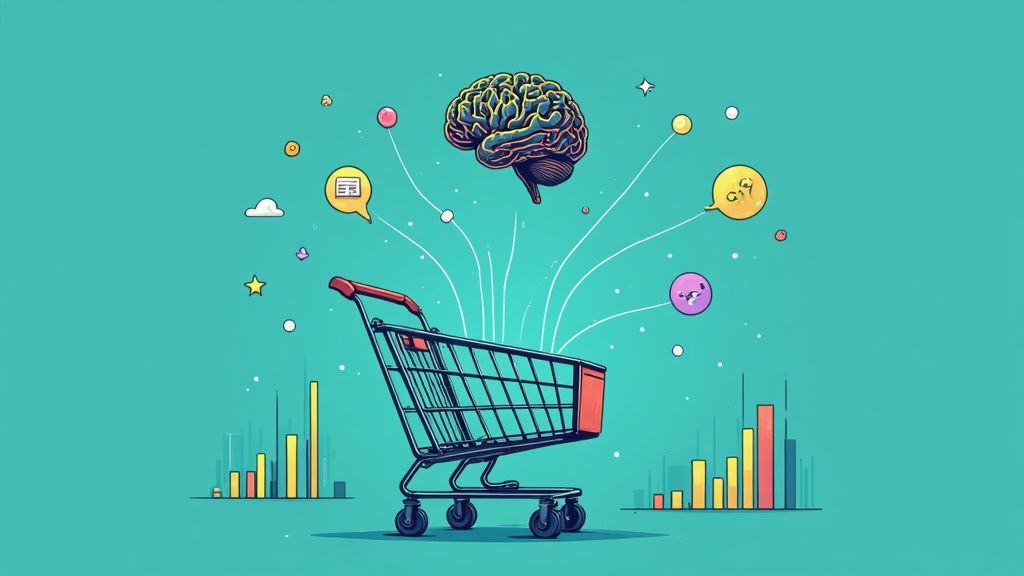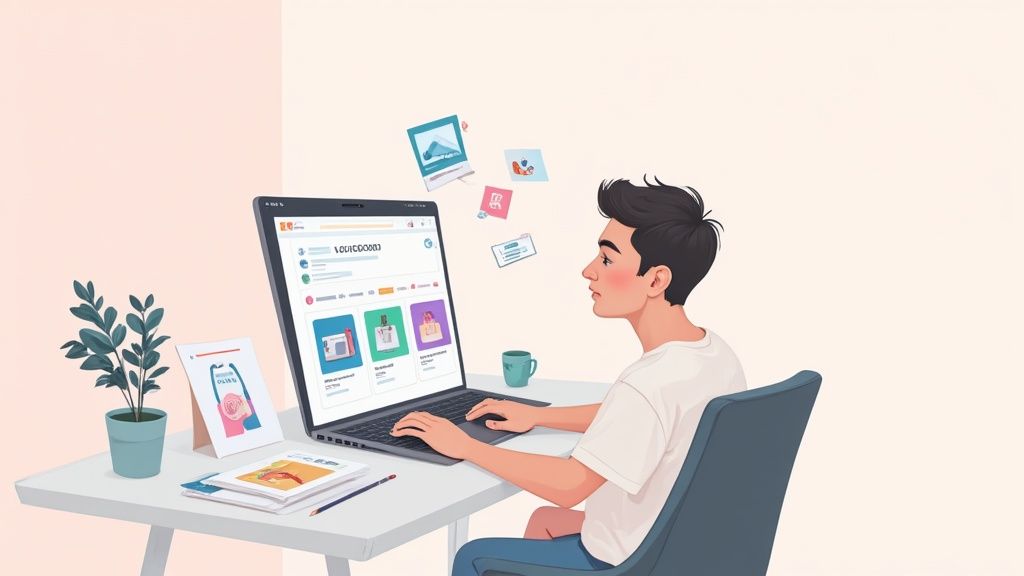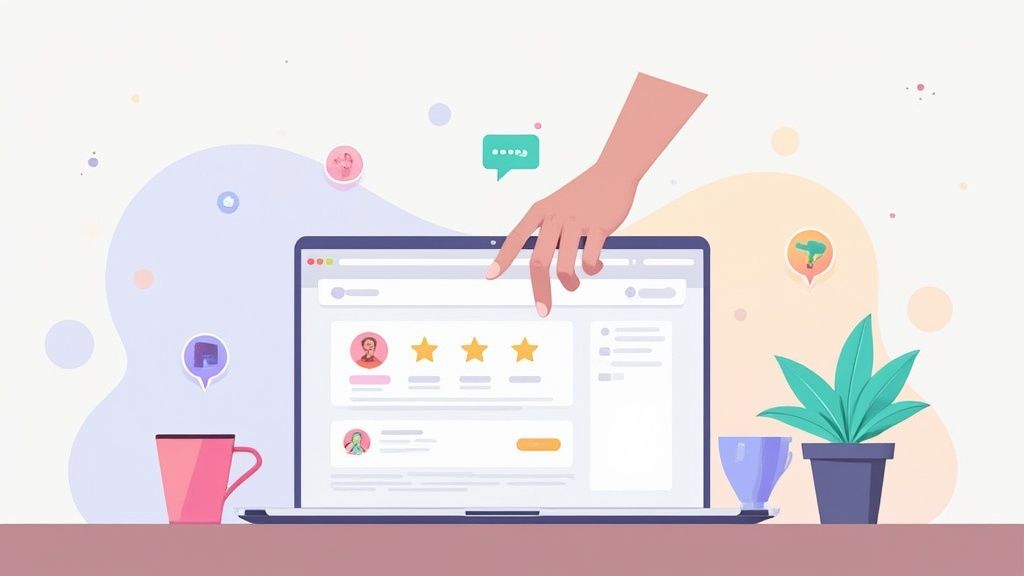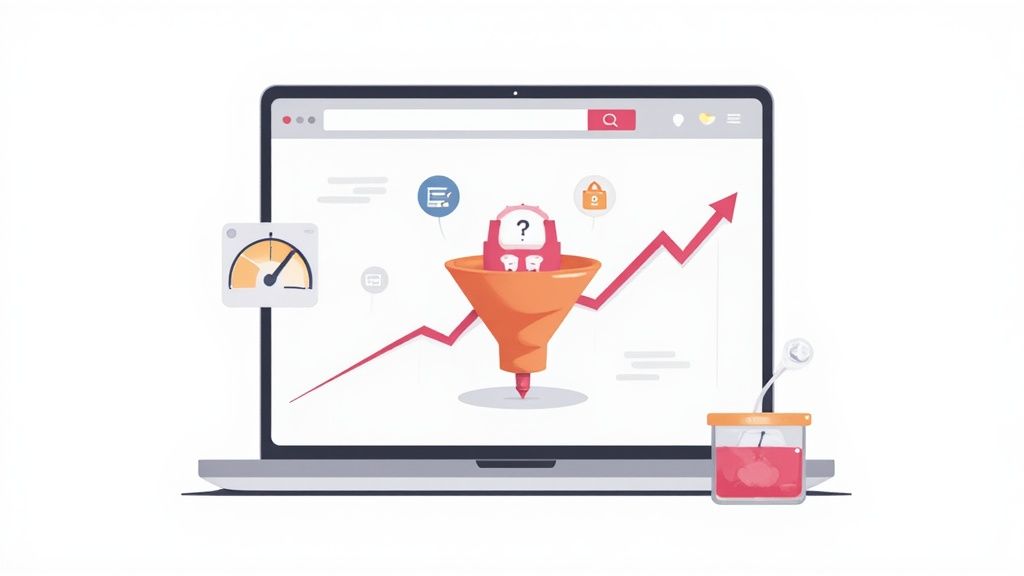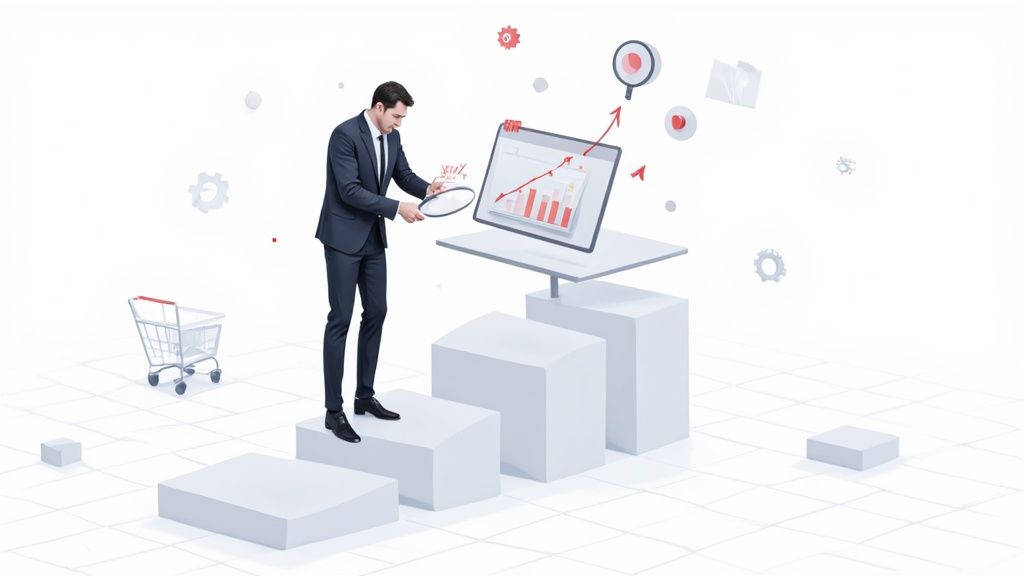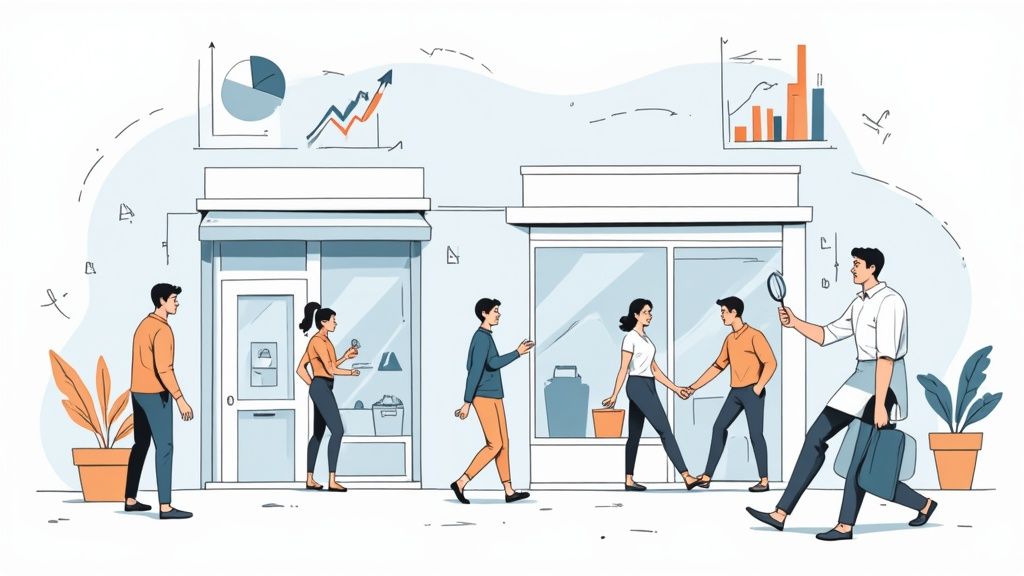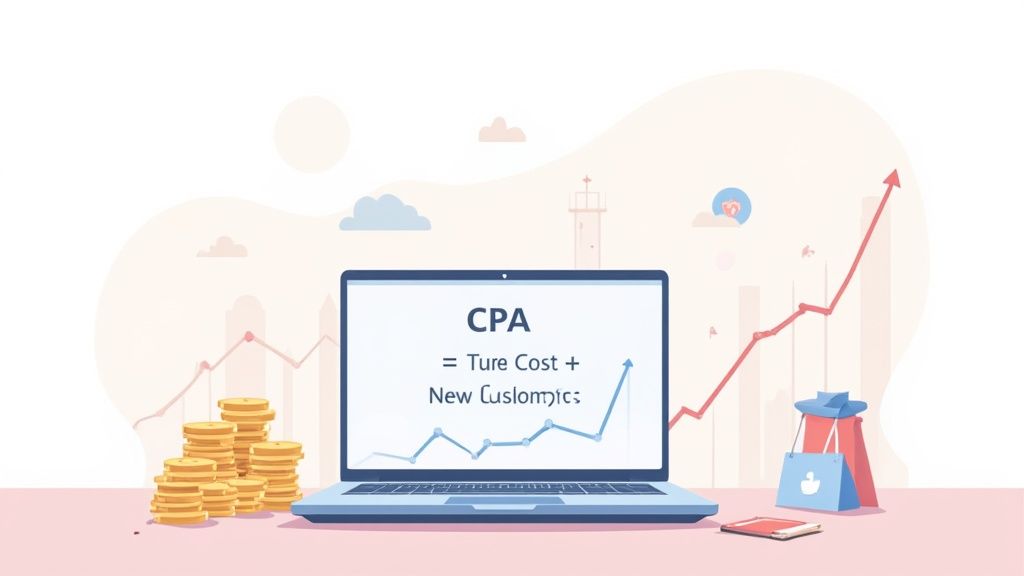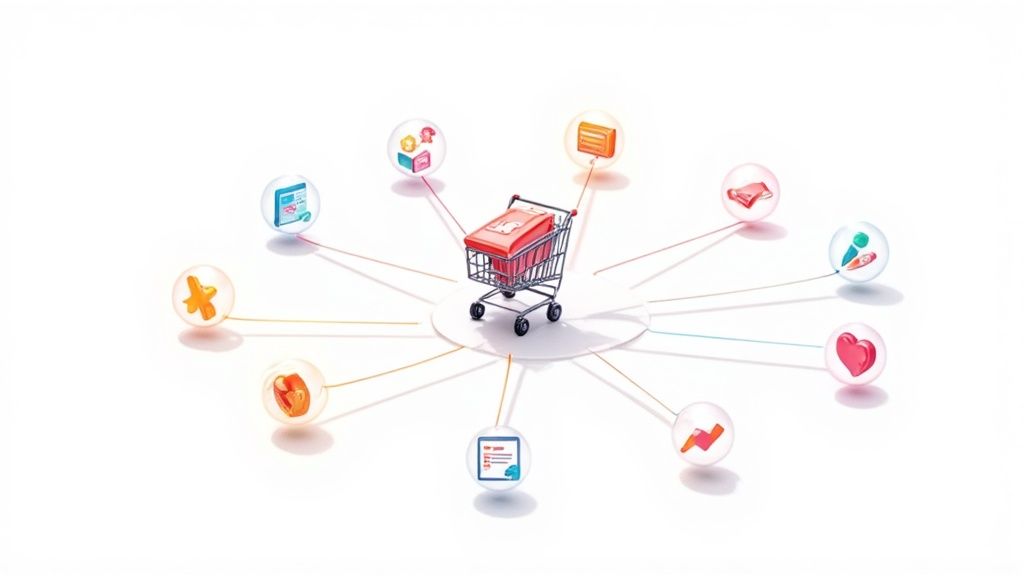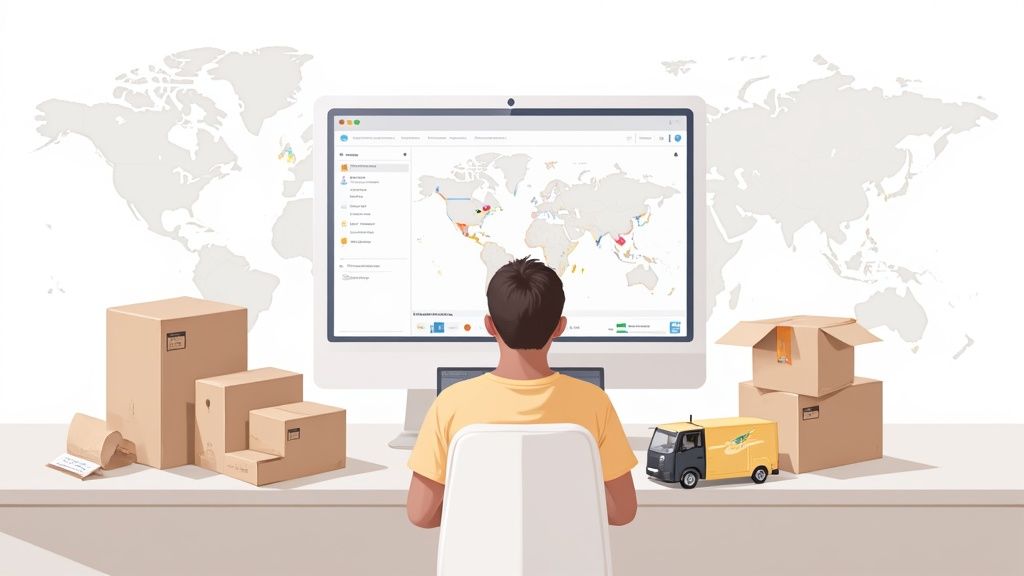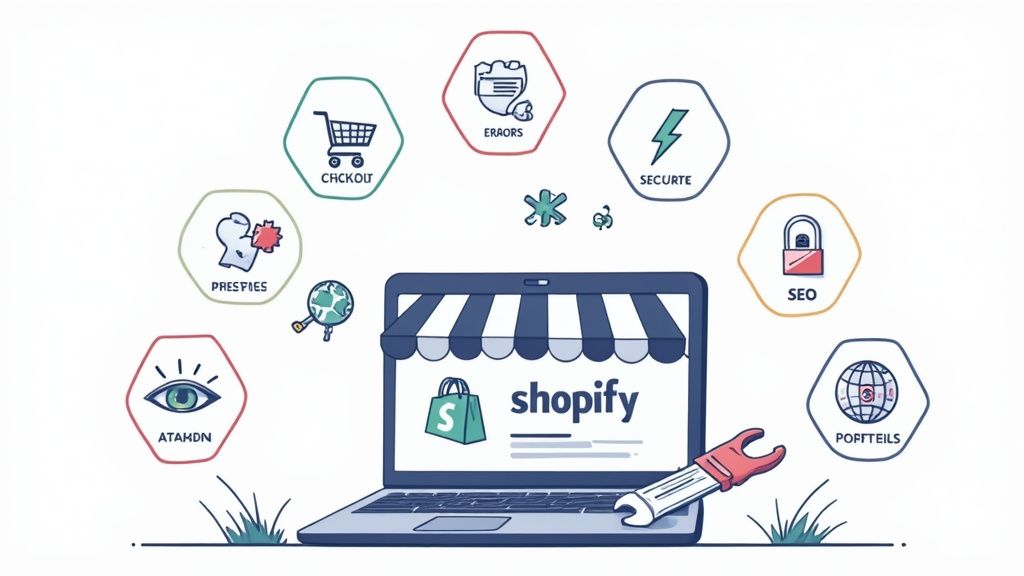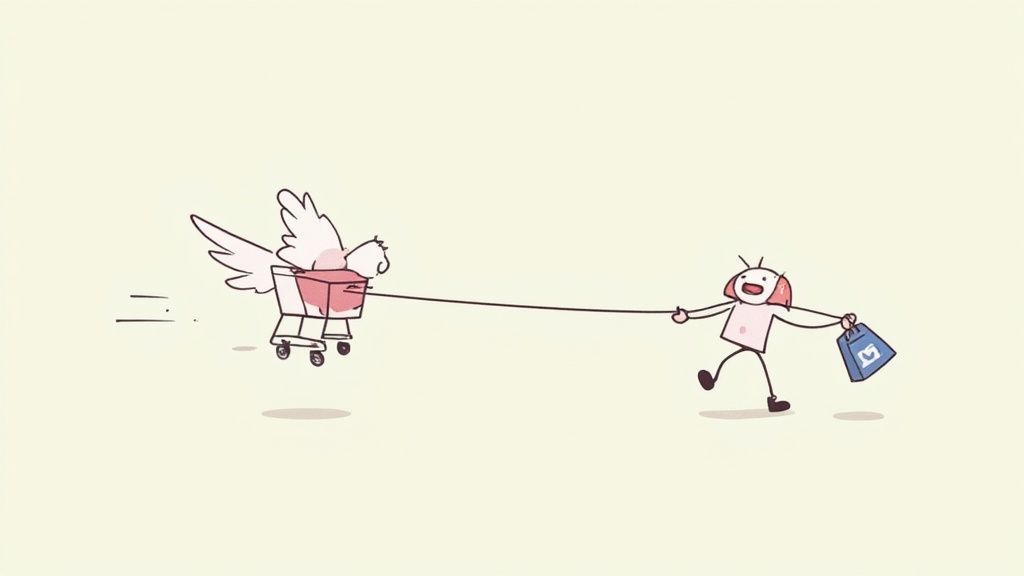
Setting up your abandoned cart emails in Shopify is one of the quickest wins you can get for your store. This isn’t just some fancy marketing tactic; it’s a direct line to shoppers who were this close to buying from you, giving you a chance to bring them back and recover that sale.
The Hidden Goldmine in Your Abandoned Carts
Think about it: every time a shopper puts an item in their cart, they're sending a huge signal. They want what you're selling. When they walk away, it’s rarely a hard "no." More often, it's a "maybe later." Maybe the dog started barking, maybe their boss walked in, or maybe they just got sticker shock from the shipping costs.
This is where you need a mental shift. An abandoned cart isn't a lost sale; it's a warm lead. Seriously. This person isn't some cold prospect you're targeting with an ad. They were just moments away from clicking "buy." Your job is to simply restart that conversation, and a smart email flow is the best tool for the job.
Why Do Shoppers Really Leave?
If you want to write recovery emails that actually work, you have to get inside your customer's head. The good news is, the reasons people abandon carts are usually more about logistics than a lack of interest in your product.
The numbers are pretty staggering. Across the globe, the average cart abandonment rate hovers around 70%. On mobile, it's even worse, jumping up to a massive 85.2%. What's the biggest deal-breaker? Unexpected costs. A whopping 48% of shoppers bail when they see shipping fees they weren't expecting. Slow websites are another conversion killer, capable of increasing abandonment by 75%. You can dive deeper into these stats and more over at cropink.com.
When you know the "why," you can tailor your emails to solve those exact problems and turn a hesitant shopper into a happy customer.
Your Email Is the Perfect Fix
Think of your abandoned cart emails less like a sales pitch and more like a helpful customer service follow-up. They’re a friendly tap on the shoulder, a gentle reminder that bridges the gap between their initial excitement and the final purchase.
An abandoned cart email is a helpful nudge that reminds a distracted customer why they were so interested in your products in the first place. It re-engages them when their intent is still red-hot.
It doesn't take much to overcome the most common hurdles. Was the customer spooked by shipping costs? An email with a simple free shipping code can be all it takes. Did they just get busy and forget? Your email pops your product right back to the top of their to-do list.
Every abandoned cart is a story with an unfinished ending. Your emails are the perfect opportunity to write a happy one.
To get this right, you need to match your email strategy to the specific reason a customer left.
Common Abandonment Reasons and Your Email Solution
Here's a quick look at why customers leave their carts and the specific email tactics you can use to bring them back.
By diagnosing the likely problem, you can prescribe the perfect email solution to get that customer back across the finish line.
Getting Your First Shopify Recovery Email Live
Putting your first recovery email into action is surprisingly simple. Shopify has a powerful, built-in feature designed for this exact job, letting you start winning back sales without needing complex third-party tools right off the bat. Think of this native tool as your first step into the world of abandoned cart emails on Shopify.
The goal here is to create a simple but effective safety net. Before you get lost in building out elaborate, multi-email sequences, just activating this single, automated email ensures you’re not leaving easy money on the table. It’s a foundational piece of your ecommerce strategy that works for you 24/7.
Navigating to the Automation Settings
First things first, you need to find the abandoned checkout settings tucked away in your Shopify admin. This is your command center for the whole process, from activation to customization.
You'll find it under the Marketing > Automations section of your Shopify dashboard.
Once you’re in, you'll see a pre-built template for abandoned checkouts. This is your starting point. Shopify gives you a solid default, but you’ll want to make a few key tweaks to make sure it matches your brand's voice and style. It's a great blueprint that just needs your personal touch to really connect with customers.
This screenshot shows the standard Shopify automation page where you can create a new workflow or manage your existing abandoned checkout email.
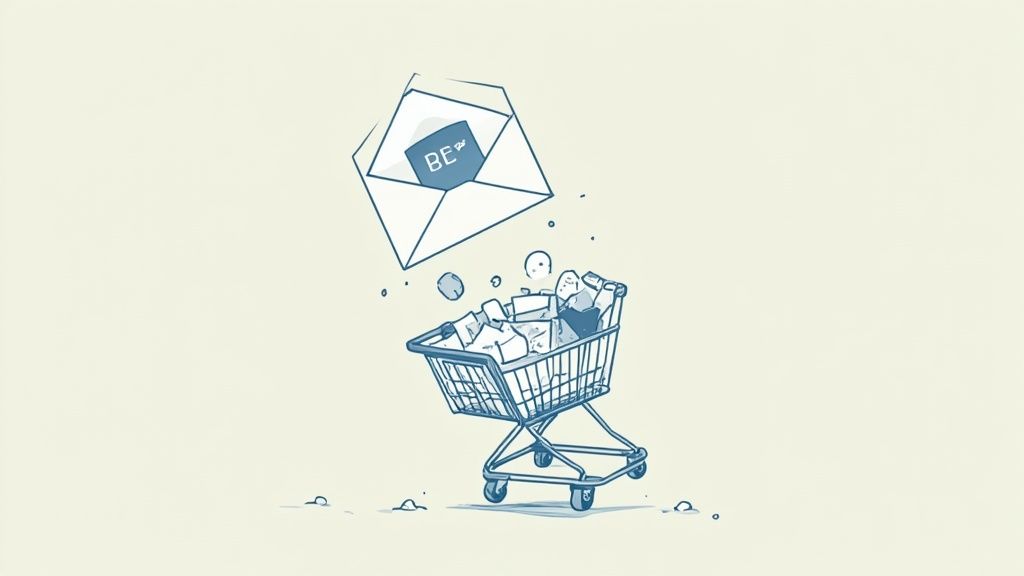
This is where you'll control your recovery efforts, letting you edit the timing, content, and activation status of your email with just a few clicks.
Customizing Your First Email
Making the default template your own is absolutely critical. It builds brand consistency and trust. Let's be honest, generic emails feel robotic and get ignored. A personalized touch, on the other hand, can make a customer feel seen and valued.
Here’s where to focus your energy:
- Subject Line: Ditch the standard "You left something behind." Get a little more creative. Try something like, "Is Your [Product Name] Getting Lonely?" or maybe "A Quick Question About Your Order."
- Email Body: This is where you inject your brand’s personality. Are you playful? Professional? Whatever your vibe is, keep the tone consistent with your website. Gently remind them what they were looking at and why it's a great choice.
- Call-to-Action (CTA): Instead of the generic "Complete your order," try something more inviting. A CTA like "Take Another Look" or "Return to Your Items" feels less demanding and lowers the pressure.
Remember, the goal of this first email isn’t just to hard-sell; it’s to re-engage a shopper who got distracted. A friendly, helpful reminder is almost always more effective than an aggressive sales pitch.
Timing is another key piece of the puzzle. Shopify gives you a few options, but sending the email 1 to 4 hours after abandonment usually hits the sweet spot. This is quick enough that the purchase is still fresh in their mind but not so quick that it feels pushy.
Once you've got this single email dialed in and working for you, you can start exploring more advanced abandonment workflows with tools like Klaviyo on Shopify to get even more granular with your control and segmentation.
Building a High-Converting Email Sequence
Moving beyond a single automated email is where you start seeing the real money. A well-thought-out multi-email sequence lets you tackle different customer hesitations over time without coming across as pushy. Building a high-converting abandoned cart email sequence is a huge part of High Performance Email Marketing, because it’s all about communicating directly to get results.
The most effective sequences follow a simple psychological arc. You start with a gentle reminder, move on to adding value, and finish with a friendly nudge of urgency.
The Gentle Reminder (Sent 1-4 Hours After Abandonment)
The first email is all about being helpful. The shopper was probably just distracted by a phone call or a barking dog. Your only goal here is to pop your products back to the top of their mind while their interest is still red-hot.
Keep this email super light, friendly, and focused. You want to avoid any aggressive sales language. Instead, think of it as a customer service touchpoint.
- Subject Line Idea: "Did you forget something?" or "Your cart is waiting for you"
- Body Copy Focus: Show them exactly what they left behind with crisp product images. Make sure there’s one single, clear call-to-action button that takes them right back to their populated cart.
The Value-Driven Incentive (Sent 24 Hours After Abandonment)
If the first email didn't reel them back in, it's clear a simple reminder isn't going to cut it. Now, it's time to address a bigger barrier—which, let's be honest, is usually price or shipping costs. This is your chance to sweeten the deal.
This email adds a compelling reason for them to act now. A simple offer like free shipping or a small discount can be the perfect nudge to get hesitant buyers over the finish line.
Pro Tip: Free shipping often feels more valuable than a percentage discount. Unexpected shipping costs are one of the biggest reasons people abandon carts, so directly solving that pain point is a game-changer.
This infographic breaks down a proven timeline for sending each email in your sequence to get the best engagement without annoying anyone.
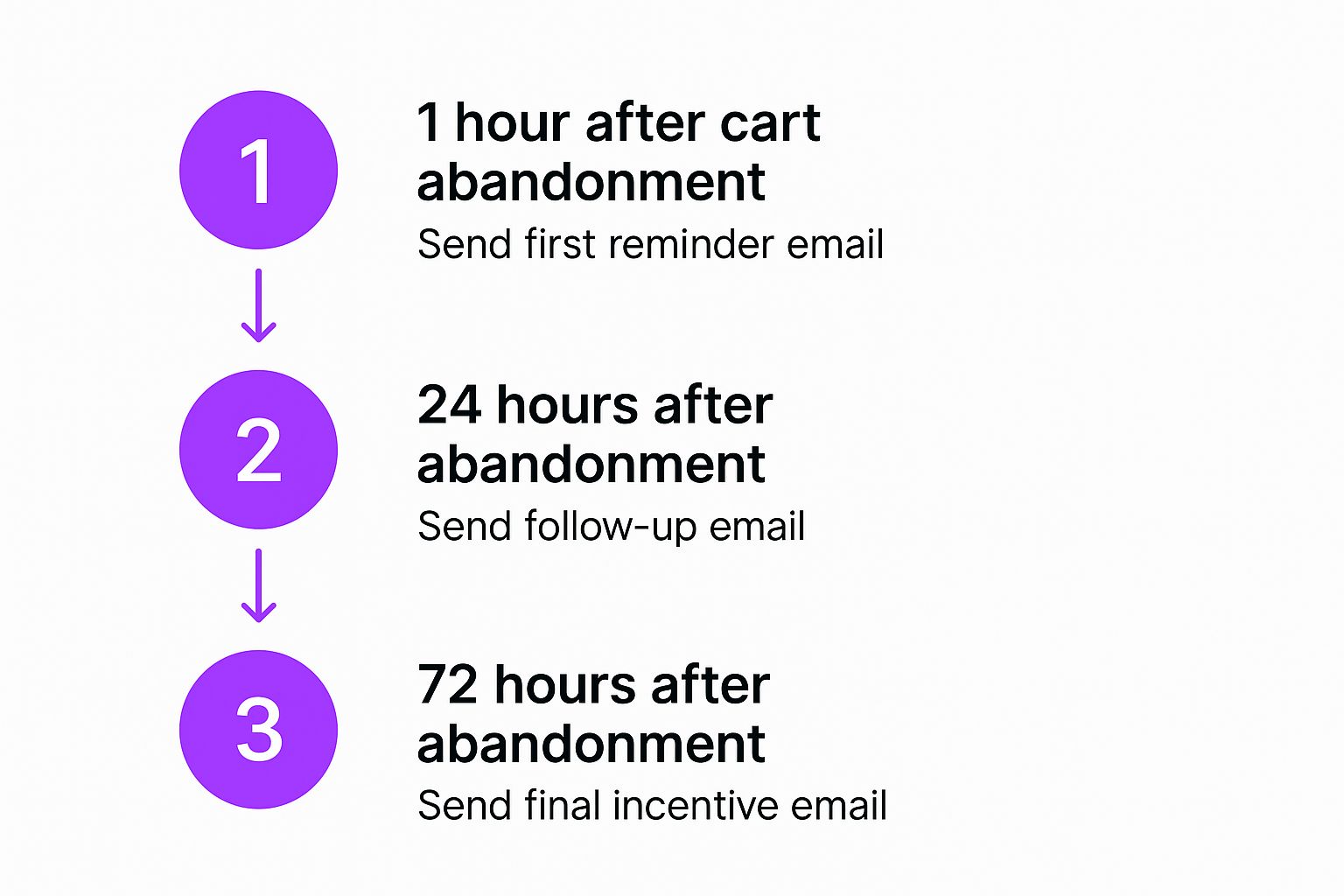
As you can see, spacing your emails lets you escalate your message without overwhelming the customer's inbox.
The Final Urgency Nudge (Sent 48-72 Hours After Abandonment)
This is your last shot. The goal here is to create a gentle sense of urgency or FOMO (fear of missing out). You’re not being forceful, just signaling that the opportunity is about to disappear.
Combine the incentive from your last email with a time limit. For instance, let them know their discount code expires in 24 hours, or that you can no longer hold the items in their cart. Shopify actually recommends a series of 3 to 5 abandoned cart emails spaced over a few days, which can claw back 10-20% of what would have been lost revenue. The key is personalization—using customer data to make the messages feel relevant.
You can also sprinkle in some social proof in this final email. Including a top-rated customer review for one of the items in their cart can build that last bit of trust they need to finally click "buy." For more great ideas, check out our collection of effective abandoned cart email examples.
Using Segmentation to Personalize Your Emails
Let's be honest: a generic, one-size-fits-all email blast is the fastest way to get your message dragged straight to the trash. If you really want to level up your abandoned cart emails on Shopify, you have to stop treating every customer the same.
This is where segmentation comes in. It’s all about slicing your audience into specific groups so you can send hyper-relevant messages that actually resonate. Instead of one flow for everyone, imagine sending a special offer to a high-value shopper, or different copy to someone who abandoned a sale item versus a new arrival.
This kind of personalization makes your emails feel less like automated marketing and more like a helpful, one-on-one conversation. The result? A huge boost in relevance and a much, much higher chance of winning back that sale.
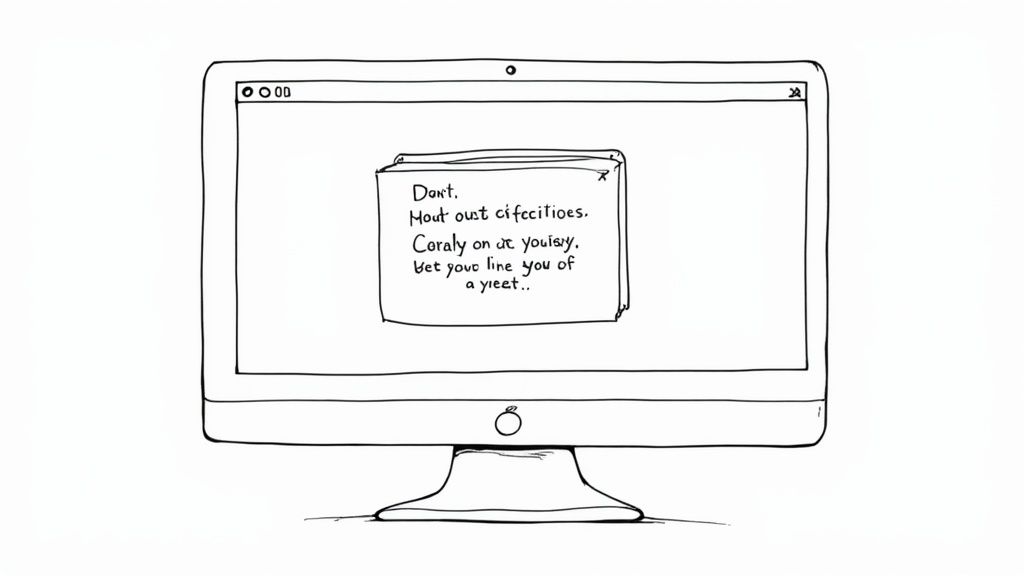
Segment by Cart Value
Not all abandoned carts are created equal. A shopper who leaves a $250 order behind has a completely different potential value than someone who abandons a $20 item. Segmenting by cart value lets you get strategic with your incentives.
- For High-Value Carts (e.g., over $150): These are your VIPs. Don't be shy. Consider offering a more substantial discount, like 15% off or free expedited shipping, to close the deal. The potential ROI here is massive.
- For Low-Value Carts (e.g., under $50): A big discount could easily wipe out your margins. Instead, a simple reminder or a small offer like free standard shipping might be all it takes to nudge them over the line without sacrificing profitability.
Treating every cart the same means you’re either giving away too much profit on small orders or not offering enough incentive on large ones. Segmentation finds that profitable middle ground.
Segment by Customer History
How you speak to a customer should depend on your relationship with them. A first-time shopper needs a totally different message than a loyal, repeat buyer. This is a classic, powerful way to build brand loyalty while recovering sales.
For instance, your email to a first-time buyer could lean heavily on social proof. Include customer testimonials or highlight your hassle-free return policy to build that initial trust. They don't know you yet, so give them a reason to believe in your brand.
For a repeat customer, you can acknowledge their loyalty directly. Maybe offer them an exclusive discount just for them, or give them an early peek at new products. It makes them feel seen and valued, which is huge for retention.
Diving deeper into key customer segmentation strategies can unlock even more powerful ways to personalize your outreach. This approach allows you to craft messages that aren't just personalized, but almost predictive of what your customer wants to hear.
Measuring and Optimizing Your Performance
Getting your abandoned cart emails on Shopify up and running is a fantastic start, but the real magic happens when you start digging into the data. You can't improve what you don't measure. By keeping an eye on the right metrics, you can transform a decent automation into a revenue-recovering powerhouse that gets smarter over time.
The trick is to zero in on a few core numbers that tell the whole story. Don't get lost in a sea of data points; start with the ones that directly fatten your wallet.
The Metrics That Actually Matter
Think of these numbers as the vital signs for your email sequence. They’ll tell you exactly where your strategy is hitting the mark and where it needs a little TLC.
- Open Rate: This is your first hurdle. It tells you how many people are actually opening your email, which is a direct reflection of how good your subject line is.
- Click-Through Rate (CTR): This measures the percentage of openers who clicked a link. A strong CTR is a sign that your email body, offer, and call-to-action are all working together beautifully.
- Conversion Rate: This is the big one—the percentage of people who finished their purchase after clicking your email. It’s the ultimate measure of success.
- Recovered Revenue: At the end of the day, this is what it's all about. This is the total dollar amount your abandoned cart flow has clawed back.
Looking at this data gives you context. For instance, industry research shows that over 40% of abandoned cart emails get opened, click rates can hover around 50%, and half of those clicks often lead to a purchase. If your numbers are falling short, that’s your cue to start tweaking. You can find more benchmarks and discover more insights about cart recovery stats on moosend.com.
The Power of A/B Testing
Once you have your baseline numbers, it's time to start making them better with some good old-fashioned A/B testing. It’s a simple concept: change one element of an email, send the two versions to different groups of people, and see which one performs better.
A/B testing is how you stop guessing and start knowing. You let your customers' actions tell you exactly what they want.
Begin by testing the things that could have the biggest impact. Your offer is a great place to start. For example, you could send one version of your second email with a 10% discount and another with free shipping. Let it run for a week or two, and you'll have a clear winner based on which one brought in more cash.
From there, you can test other crucial pieces like your subject lines, send times, or even the tone of your copy. The golden rule is to test just one thing at a time. That's how you get clean, reliable results you can act on.
Common Questions About Shopify Cart Recovery
Even with a perfectly tweaked email sequence, questions always come up when you're managing abandoned cart emails on Shopify. Getting the details right—from the legal stuff to the strategic choices—can be the difference between a successful recovery campaign and leaving money on the table. Let's dig into the most common questions I hear from store owners.

This section is all about giving you clear, straightforward answers so you can run your cart recovery strategy with confidence.
Can I Email Shoppers Who Did Not Accept Marketing
Surprisingly, yes—but only for abandoned checkouts. This is a common point of confusion. Shopify classifies these recovery emails as transactional because the customer started the buying process and gave you their email for that purpose. That gives you the green light to send the recovery sequence, even if they haven't opted into your regular marketing newsletter.
Just be careful here. This permission is a one-trick pony; it's strictly for recovering that specific abandoned checkout. You absolutely cannot add these shoppers to your general marketing lists without their explicit consent.
Crucial Takeaway: Keep a close eye on regional privacy laws like GDPR and CCPA. While abandoned checkout emails are generally seen as transactional, compliance isn't optional. It's how you build trust right from the start.
What Is a Good Discount to Offer
There's no magic number that works for everyone. The right discount really depends on your product margins and what actually motivates your customers. The best way to figure this out is to A/B test a percentage-based offer against a value-based one.
Here are a few solid starting points:
- Percentage Off: An offer like 10% or 15% off is a simple, effective incentive that works well across most product categories. It's easy for customers to understand instantly.
- Free Shipping: Since unexpected shipping costs are a top reason for cart abandonment, offering free shipping tackles a huge pain point head-on. Honestly, this is often more powerful than a small percentage discount.
- Tiered Discount: If you have higher-value carts, try a tiered offer like $20 off orders over $100. This not only gives them a reason to finish the purchase but also nudges them to maintain a higher order value.
At the end of the day, let your data be your guide. Your A/B test results will show you which incentive hits that sweet spot of boosting conversions while protecting your profitability.
Should I Use a Third-Party App or Shopify's Built-In Tool
Think of this as a "walk before you run" situation. For most store owners, Shopify's built-in tool is the perfect place to start. It’s free, super easy to set up, and more than capable of running a solid single-email recovery flow. Master this first to get a handle on the fundamentals.
You'll know it's time to upgrade to a more advanced third-party app, like Klaviyo or Omnisend, when your strategy starts feeling limited by the native features. These platforms open up a whole new world of control.
Consider a third-party app when you need:
- Sophisticated Workflow Builders: To create complex, multi-email sequences with smart logic (e.g., sending different messages to first-time vs. repeat buyers).
- Deeper Segmentation Options: To target customers based on their browsing behavior, purchase history, or even predicted lifetime value.
- Advanced A/B Testing: To test more than just subject lines—you can compare entire email designs, different workflows, and even multi-channel strategies.
- Multi-Channel Recovery: To weave in SMS messages for a more immediate and personal touchpoint.
Start with Shopify's native tool and build your foundation. Once you're consistently recovering sales and find yourself wishing you could do more, that's your cue to explore what a dedicated email marketing platform can do for you.






